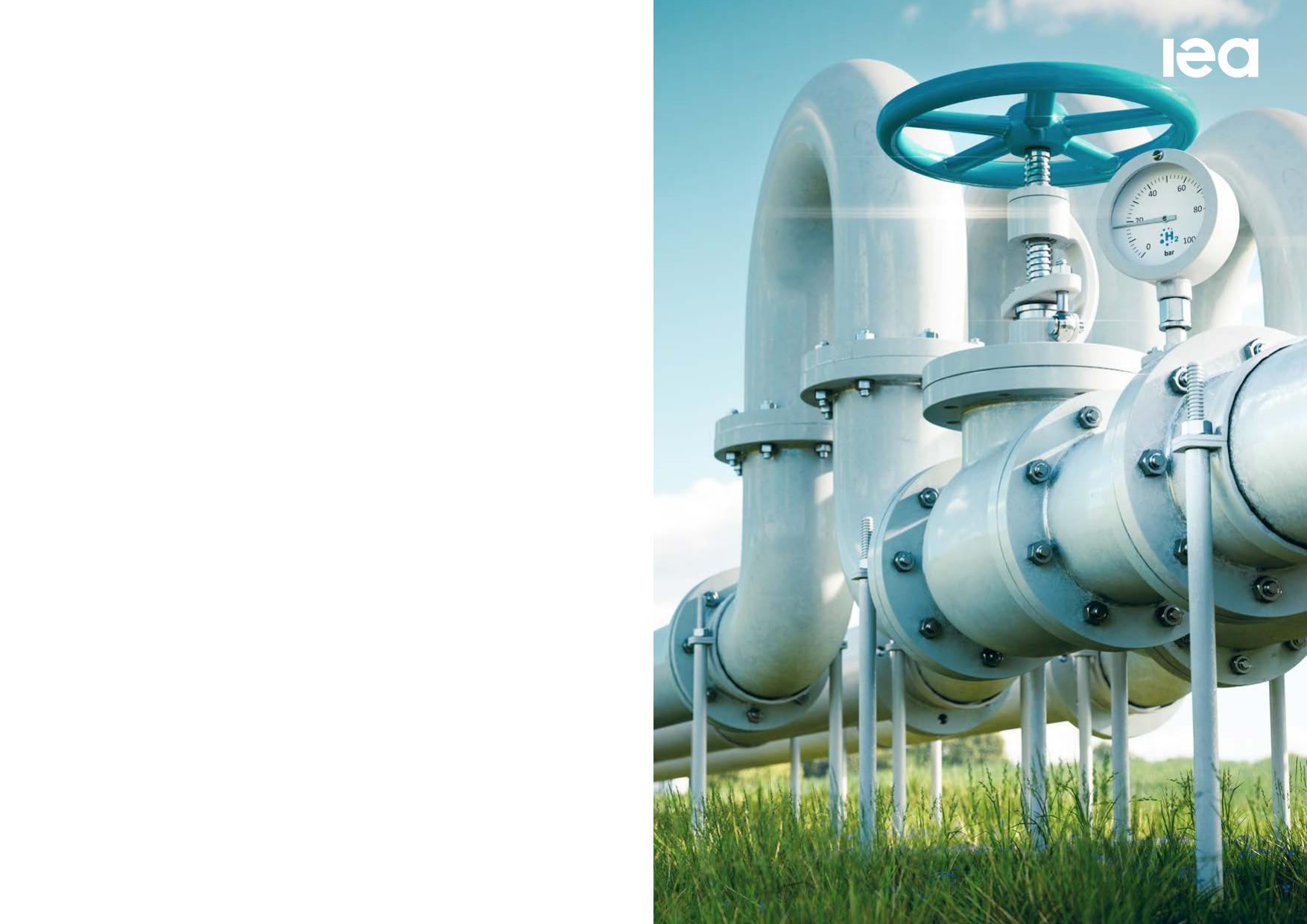NorthwestEuropeanHydrogenMonitorTheIEAexaminesthefullspectrumofenergyissuesincludingoil,gasandcoalsupplyanddemand,renewableenergytechnologies,electricitymarkets,energyefficiency,accesstoenergy,demandsidemanagementandmuchmore.Throughitswork,theIEAadvocatespoliciesthatwillenhancethereliability,affordabilityandsustainabilityofenergyinits31membercountries,11associationcountriesandbeyond.Thispublicationandanymapincludedhereinarewithoutprejudicetothestatusoforsovereigntyoveranyterritory,tothedelimitationofinternationalfrontiersandboundariesandtothenameofanyterritory,cityorarea.Source:IEA.InternationalEnergyAgencyWebsite:www.iea.orgIEAmembercountries:AustraliaAustriaBelgiumCanadaCzechRepublicDenmarkEstoniaFinlandFranceGermanyGreeceHungaryIrelandItalyJapanKoreaLithuaniaLuxembourgMexicoNetherlandsNewZealandNorwayPolandPortugalSlovakRepublicINTERNATIONALENERGYAGENCYSpainSwedenSwitzerlandRepublicofTürkiyeUnitedKingdomUnitedStatesTheEuropeanCommissionalsoparticipatesintheworkoftheIEAIEAassociationcountries:ArgentinaBrazilChinaEgyptIndiaIndonesiaMoroccoSingaporeSouthAfricaThailandUkraineNorthwestEuropeanHydrogenMonitorPAGE2IEA.Allrightsreserved.AbstractAbstractNorthwestEuropeisattheforefrontofrenewableandlow-emissionhydrogendevelopment.ThisregionaccountsforaroundhalfofEurope’stotalhydrogendemand,andhasavastanduntappedrenewableenergypotentialintheNorthSea.Italsohasawell-developed,interconnectedgasnetworkwhichcouldbepartiallyrepurposedtofacilitatethetransmissionanddistributionofrenewableandlow-emissionhydrogenfromproductionsitestodemandcentres.Thedevelopmentofrenewableandlow-emissionhydrogen1inNorthwestEuropeisexpectedtograduallyscaleupintheshort-tomedium-termtoreachalow-emissionhydrogenproductioncapacitytargetofover30GWby2030.Mostofthelow-emissionhydrogenprojectsarecurrentlyintheearlystagesofdevelopment.Theirsuccesswilldependtoalargeextentonthesupportingpolicyandregulatoryframeworks,andcontinuousmonitoringofprogress.Thecost-efficientdevelopmentofrenewableandlow-emissionhydrogenmarketswillalsonecessitatearegionalapproachinordertomaximisetheexistingsynergiesamongstnationalmarkets.1Whentheterm“low-emissionhydrogen”isused,theInternationalEnergyAgencyreferstohydrogenproducedviaelectrolysiswheretheelectricityisgeneratedfromalow-emissionsource(renewablesornuclear),biomassorfossilfuelswithcarboncaptureusageandstorage(CCUS).ThisdoesnotnecessarilyreflecttheofficialdefinitionsofthecountriesinvolvedintheMonitoronthecarbonintensityorsustainabilityofhydrogenproductionmethods.ThisisthefirsteditionoftheNorthwestEuropeanHydrogenMonitor.Itaimstoprovideanannualupdateoftherenewableandlow-emissionhydrogenmarketdevelopmentsinNorthwestEurope.ItistheresultofacollaborationamongthecountriesinvolvedintheHydrogenInitiativeoftheCleanEnergyMinisterial(CEM-H2I)workstreamentitled,“RoundtableontheNorth-WestEuropeanRegion”andthehydrogenworkinggroupofthePentalateralForum.Thecountriesanalysedinthismonitorare:Austria,Belgium,Denmark,France,Germany,Luxemburg,theNetherlands,Norway,SwitzerlandandtheUnitedKingdom.Marketmonitoringisaccompaniedbyacontinuousdialoguewithkeystakeholderstofacilitateinformationexchangeanddatacollection.BriefingnoteonrecentLNGmarketandcontractingtrendsPAGE3IntroductionTableofcontentsNorthwestEuropeanHydrogenMonitor..............................................1Abstract..........................................................................................2Tableofcontents...........................................................................3Executivesummary........................................................................4Hydrogenpoliciesandtargets..............................................................9HydrogentargetsinNorthwestEuropearebeingscaledup.......10MostNorthwestEuropeancountrieshaveadoptedhydrogenstrategies.....................................................................................11NorthwestEuropetargetsatleast30GWofinstalledelectrolysisproductioncapacityby2030........................................................19Subsidyschemesandsupportmechanisms....................................21Subsidiesandsupportmechanismswillbekeyfortheearlydeploymentoflow-emissionhydrogeninNorthwestEurope......22SeveralEUfundingprogrammesareavailableforhydrogenprojects........................................................................................25Hydrogensupply..................................................................................36Low-emissionhydrogenisattheintersectionofdecarbonisationeffortsandenergysupplysecurity...............................................37NorthwestEuropeleadstheworldinlow-emissionhydrogenproductiondevelopment..............................................................39Low-emissionhydrogenproductiondevelopmentvariesbycountry.........................................................................................41Hydrogentrade.....................................................................................48Europeancountriescouldplayacentralroleinanascenthydrogentrademarket.................................................................49Dedicatedfinancialinstrumentswillbekeytofacilitatinghydrogenimports.........................................................................................50Thenumberofplannedexport-orientedprojectsisgrowing,butaconsiderablemarginexistsforsecuringoff-takeagreements.....51Hydrogendemand................................................................................56Demandcreationwillbecrucialincreatingalow-emissionhydrogenmarket..........................................................................57Low-emissionhydrogendemandinNorthwestEuropecouldreachcloseto7Mt/yrby2030....................................................62Infrastructure........................................................................................63Dedicatedhydrogeninfrastructurewillbekeyforthelarge-scaledeploymentoflow-emissionhydrogen........................................64NorthwestEuropeancountriesleadthewayininfrastructuredevelopment................................................................................66Regulation.............................................................................................74Developinganeffectiveregulatoryframeworkwillbecrucialtofast-trackingthedeploymentoflow-emissionhydrogen.............75HarmonisedhydrogenstandardsandcertificationschemeswillbekeytoestablishingaregionalhydrogenmarketinNorthwestEurope.........................................................................................77Harmonisedhydrogenblendingthresholdscouldfacilitatethedevelopmentoflow-emissionhydrogentradeinNorthwestEurope.........................................................................................80Costsofhydrogenproduction............................................................83Highgas......................................................................................84HydrogenproductioncostoutlookinNorthwestEurope............85Annex.................................................................................................88Keylow-emissionhydrogenprojectsinNorthwestEurope.........89Regionalandcountrygroupings..................................................90Abbreviationsandacronyms.......................................................91Unitsofmeasure.........................................................................92Acknowledgments,contributorsandcredits................................93NorthwestEuropeanHydrogenMonitorPAGE4IEA.Allrightsreserved.ExecutivesummaryExecutivesummaryLow-emissionhydrogencanplayasignificantroleindecarbonisingexistinggasandenergysystemsandwillbecriticaltothecountries’effortstoachieveaclimateneutralsociety.Besidesitsenvironmentalbenefits,low-emissionhydrogencanalreadyhelpreducerelianceonfossilfuelimportsinthemedium-term.NorthwestEurope2leadsthedevelopmentoflow-emissionhydrogenasanewenergycarrier.ThisregionaccountsforaroundhalfofEurope’stotalhydrogendemand,andhasavastanduntappedrenewableenergypotentialintheNorthSea.Italsohasawell-developed,interconnectedgasnetworkwhichcouldbepartiallyrepurposedtofacilitatethetransmissionanddistributionofrenewableandlow-emissionhydrogenfromproductionsitestodemandcentres.Whentheterm“low-emissionhydrogen”isused,theInternationalEnergyAgencyreferstohydrogenproducedviaelectrolysiswheretheelectricityisgeneratedfromalow-emissionsource(renewablesornuclear),biomassorfossilfuelswithcarboncaptureusageandstorage(CCUS).ThisdoesnotnecessarilyreflecttheofficialdefinitionsofthecountriesinvolvedintheMonitoronthecarbonintensityorsustainabilityofhydrogenproductionmethods.2TheNorthwestEuropeanHydrogenMonitorcoversthefollowingcountries:Austria,Belgium,Denmark,France,Germany,Luxembourg,Netherlands,Norway,SwitzerlandandtheUnitedKingdom.NorthwestEuropehassetatargetof30-40GWofelectrolysercapacityby2030Theadoptionofhydrogenstrategies,includingmedium-andlong-termtargets,isconsideredessentialinprovidingthenecessaryimpetusandguidanceforthedevelopmentsofhydrogenmarkets.InNorthwestEurope,nineofthetencountriesincludedintheMonitorhavealreadydevelopedhydrogenstrategiesorroadmaps,andsixhaveadoptedspecificproductioncapacitytargetsupto2030.FollowingRussia’sunprovokedinvasionofUkraine,severalNorthwestEuropeancountrieshavedoubled,orareconsideringraisingtheirproductiontargets.Whilemostofthecountrieshaveadoptedproductiontargetsforelectrolytichydrogen,Norwayhasoptedforatechnology-neutralapproach.Inall,theNorthwestEuropeancountriestargetelectrolysercapacitydeploymentofbetween30and40GWby2030.Low-emissionhydrogenproductioncouldfullyreplaceunabated,fossil-fuelbasedhydrogenby2030inNorthwestEurope…Ifallannouncedandplannedprojectsbecomecommerciallyoperational,NorthwestEurope’slow-emissionhydrogenproductionNorthwestEuropeanHydrogenMonitorPAGE5IEA.Allrightsreserved.Executivesummarycapacityisexpectedtoreachcloseto14MtH2/yrby2030.ThiswouldmeanthatNorthwestEuropewouldaccountforaround80%ofthetotalexpectedproductioncapacityoflow-emissionhydrogenproductioninOECDEuropeby2030.Electrolytichydrogenissettotakethelead,meetingapproximatelytwo-thirdsofthetotalplannedlow-emissionhydrogenproductioncapacityby2030,whilsttheshareoffossil-fuelbasedhydrogenprojects,equippedwithCCUSwouldaccountforaboutone-thirdoftheprojectedproductioncapacity.Takingintoaccountassumptionsrelatingtoefficiencyandutilisationfactors,NorthwestEurope’slow-emissionhydrogenproductioncouldreachcloseto6.2MtH2/yrby2030,potentiallyenablingthereplacementoftheregion’scurrentuseofunabated,fossil-fuelbasedhydrogen.…however,over95%ofthelow-emissionhydrogenprojectsareintheearlystagesofdevelopment,highlightingtheneedforsupportmechanismsandsubsidyschemesAccordingtotheIEA’sHydrogenProjectsDatabase,lessthan5%oftheplannedcapacityby2030hasreachedafinalinvestmentdecision(FID)orisunderconstruction.Over95%oftheseprojectsareinvariousearlystagesofdevelopment,i.e.eitherconceptualorsubjecttofeasibilitystudies.Thishighlightstheimportanceofsubsidyschemesandsupportmechanisms.Thescale-upoflow-emissionhydrogenwillrequireaneffectiveframeworkofsupportmechanismsandsubsidyschemesalongtheentirevaluechain,i.e.R&D,production,transportationanddemandcreation.Publicfundingprogrammesandstate-backedrisk-sharingmechanisms(suchascontractsfordifference)canhelptode-riskinvestmentandimprovetheeconomicfeasibilityoflow-emissionhydrogenprojects.Demandcreationshouldbeusedasakeyinstrumenttostimulateinvestment,includingviaquotasandpublicprocurementrules.ThisHydrogenMonitorprovidesadetailedoverviewofthevarioussubsidyschemesandsupportmechanismsthatareavailable,andaregivenatboththeleveloftheEuropeanUnionandatthenationallevelinNorthwestEuropeancountries.NorthwestEuropeisplayingakeyroleindevelopinginternationaltradeinlow-emissionhydrogenBasedontheexport-orientedprojectscurrentlyunderdevelopment,globalhydrogentradecouldreach12MtH2/yrby2030.However,becauseoff-takeagreementsandimportcontractsarelaggingbehind,theprojectswhichhavereachedamoreadvancedstageofdevelopmentrepresentonly0.2MtH2/yr.TheroleofportsintheNorthwestEuropeanregionwillbepivotalinthedevelopmentofanewimportmarketforcleanhydrogen.MajorportsintheNetherlands,namelythePortofRotterdamandthePortofAmsterdam,haveplanstoimportacombinedamountofmorethan5MtH2by2030.InGermany,theH2Globalauction-basedmechanismwillfacilitatetheconclusionoflong-termimportcontractsforlow-emissionNorthwestEuropeanHydrogenMonitorPAGE6IEA.Allrightsreserved.Executivesummaryhydrogenandhydrogenderivatives.TheGermangovernmenthasapprovedagrantofEUR900millionforthescheme.Notably,theGermangovernment'sdraftbudgetfor2023includesabudgetofEUR3.6billionforH2Global.InOctober2022,theNetherlandsexpresseditsinterestinjoiningH2Global.Thescale-upofinternationaltradeinhydrogenandhydrogenderivativeswillalsorequiretheconstructionoftransportinfrastructure.Liquefiedhydrogentradestillrequirestechnologydevelopment.Thereisonlyonedemonstrationprojectforhydrogentransportintheworld.ItoriginatesinAustraliaandgoestoJapan,withthefirstshipmentdeliveredinFebruary2022.Incontrasttohydrogen,ammoniaisalreadyawidelytradedcommodity.However,usingitasahydrogencarrierwouldrequireasignificantexpansionoftheglobalsupplychain.Forexample,usingammoniaasahydrogencarriertoachievetheREPowerEU’stargetof10Mt/yrhydrogenimportsby2030,wouldrequireover60Mt/yrofammonia,orthreetimesitscurrentglobaltradevolume.Moreover,iftheend-usesrequirehydrogen,ammoniamustbereconvertedtohydrogenviaammoniacracking,whichisanenergy-intensiveprocess(consumingaround30%oftheenergycontentoftheammonia).NorthwestEurope’shydrogennetworkissettoexpandalmosteight-foldby2030NorthwestEuropehasaround1600kmofhydrogenpipelines,accountingforover95%ofthehydrogenpipelinesoperationalinEurope.Mostareclosedsystemsownedbylargemerchanthydrogenproducersandareconcentratednearindustrialconsumercentres.Achievingtheambitioustargetsintermsoflow-emissionhydrogendeploymentwillrequireacceleratingthedevelopmentofhydrogeninfrastructurefortransportandstorage.BasedonthecurrenttargetssetbyNorthwestEuropeancountries,theregion’shydrogennetworkcouldincreasebyalmosteight-foldtoover12000kmby2030.Repurposinggaspipelinestohydrogenservicecouldcutinvestmentcostsby50-80%comparedtothecostofbuildingnewpipelines.Thisinturn,couldtranslateintolowertransmissiontariffsandimprovethecost-competitivenessoflow-emissionhydrogen.Accordingtofirstestimates,closetotwo-thirdsofthehydrogenpipelinesoperationalin2030wouldberepurposednaturalgaspipelines.Low-emissionhydrogencouldenhanceoverallenergysystemflexibilitybybalancingshort-termsupplyvariabilityandmeetingseasonaldemandswings,therebyimprovingenergysupplysecurity.Tofulfilthisrole,low-carbonhydrogendeploymentwillneedtobecoupledwithdevelopmentofcost-effective,large-scaleandlong-termstoragesolutions.SeveralundergroundhydrogenstorageprojectsarecurrentlyundervariousphasesofdevelopmentinNorthwestEurope.NorthwestEuropeanHydrogenMonitorPAGE7IEA.Allrightsreserved.ExecutivesummaryDevelopingaharmonisedregulatoryframeworkwillbecrucialtoenablingregionaltradinginlow-emissionhydrogenHarmonisedregulatoryframeworksforhydrogenenablethedevelopmentofregionaltradeinlow-emissionhydrogen.Theywouldalsobenefitcross-regionalsynergiesintermsofproductionanddemandcreation.TheEuropeanCommissionpublisheditsHydrogenandDecarbonisedGasMarketPackageinDecember2021.Thispackagelaysdownthefoundationsfortheintegrationoflow-emissiongases,includinghydrogen,intothebroaderEuropeangassystem.Theproposedregulationprovidesguidelinesonthegradualimplementationofnon-discriminatorythird-partyaccesstohydrogennetworks,blendinglimits,tariffs,networkcodesandoperationaltransparency.Regulatorystandardsforlow-emissionhydrogenareemerginginNorthwestEurope.IntheUnitedKingdom,theLowCarbonHydrogenStandardPolicydefineslow-carbonhydrogenwithanemissionsintensitylowerthan2.4kgCO2-eq/kgofproducedhydrogen.HydrogenproducersseekingsupportfromcertainUKGovernmentprogrammesmustadheretothisstandard.IntheEuropeanUnion,theEuropeanCommissionproposedanemissionsthresholdof3.38kgCO2-eq/kgH2,whichis70%lowerthanthatofthepredefinedfossilfuelcomparatorincludingtransportandothernon-productionemissions.Harmonisedapproachestohydrogencertificationschemes–providingevidenceoftheemissionsintensityofagivenunitofhydrogen–willbekeyinestablishingaregionalhydrogenmarketinNorthwestEuropeamidsttighteningregulatorystandards.Similarly,hydrogenblendingthresholdsshouldbeharmonisedtofacilitateregionaltrading.Renewableelectrolytichydrogenwouldbecompetitivewithunabatedgas-basedhydrogenby2030Thecostofunabatedgas-basedhydrogenroseabovetheestimatedcostofwind-basedelectrolytichydrogenin2022amidstthesurgeingaspricestorecordlevels.Naturalgasmarketsareexpectedtoremaintightuntilthemid-2020s,andthissituationcouldacceleratethetransitiontowardsrenewables-basedelectrolytichydrogen.Ourprojectionsindicatethatrenewableelectrolytichydrogenwillbecompetitivewithgas-basedhydrogenby2030,evenifitisassumedthatnaturalgaspricesreturntotheirpre-crisisaveragelevels.NorthwestEuropeanHydrogenMonitorPAGE8IEA.Allrightsreserved.ExecutivesummaryOver95%ofNorthwestEurope’splannedlow-emissionhydrogenproductioncapacityisintheearlystagesofdevelopmentandwillrequirepolicysupporttotakeoffIEA.CCBY4.0.Source:IEA(2022),HydrogenProjectsDatabase.Low-emissionhydrogenprojectcapacityinNorthwestEuropebystatus,2021-2030NorthwestEuropeanHydrogenMonitorPAGE9IEA.Allrightsreserved.HydrogenpoliciesandtargetsHydrogenpoliciesandtargetsNorthwestEuropeanHydrogenMonitorPAGE10IEA.Allrightsreserved.HydrogenpoliciesandtargetsHydrogentargetsinNorthwestEuropearebeingscaledupTheadoptionofhydrogenstrategies,includingmedium-andlong-termtargets,areconsideredessentialtoprovidetheimpetusandguidancenecessaryforthedevelopmentofhydrogenmarkets.TheEuropeanUnion’sHydrogenStrategy,publishedinJuly2020,providedavisiontocreateaEuropeanhydrogenecosystemandtoscaleupproductionandinfrastructuretoaninternationaldimension.TheStrategyspansthreephasesforthedevelopmentoflow-emissionhydrogen:•Inthefirstphase,from2020upto2024,thestrategicobjectiveistoinstallatleast6GWofrenewablehydrogenelectrolysersintheEU,withtheaimtoproduceupto1Mtofrenewablehydrogeninordertodecarboniseexistinghydrogenproduction(e.g.inthechemicalsector).•Inthesecondphase,from2025to2030,hydrogenisexpectedtobecomeanintrinsicpartofanintegratedenergysystem.Thetargetistoinstallatleast40GWofrenewablehydrogenelectrolysersby2030.•Inthethirdphase,from2030onwardsandtowards2050,renewablehydrogentechnologiesareexpectedtoreachmaturityandbedeployedatlargescaletoreachallhard-to-decarbonisesectorswhereotheralternativesmightnotbefeasibleorhavehighercosts.InNorthwestEurope,ofthetencountriesincludedintheMonitor,sixhavealreadyadoptedspecificproductiontargetsby2030.Altogether,NorthwestEuropeancountriesforeseeelectrolysercapacitydeploymentbetween30and40GWby2030.SinceRussia’sunprovokedinvasionofUkraine,severalNorthwestEuropeancountrieshavedoubled,orareconsideringincreasingtheirproductiontargets.Similarly,theEuropeanUnionhasraiseditstargetforhydrogenproductionfrom5.6Mtto10Mtby2030,complementedby10Mtofimports.Dependingontheend-usesector,therapidscale-upoflow-emissionhydrogencouldreplace34-68bcm/yrofnaturalgasby2030(equatingto25%-50%oftheEuropeanUnion’sRussianpipedimportsin2021).Similarly,theUnitedKingdominApril2022doubleditsambitionforlow-carbonhydrogenproductioncapacityfrom5GWtoupto10GWby2030,withatleasthalfofthisfromelectrolytichydrogen.ThefollowingsectionprovidesanoverviewofthekeyhydrogenpoliciesandproductiontargetsadoptedbytheNorthwestEuropeancountriescoveredinthisMonitor.NorthwestEuropeanHydrogenMonitorPAGE11IEA.Allrightsreserved.HydrogenpoliciesandtargetsMostNorthwestEuropeancountrieshaveadoptedhydrogenstrategiesIEA.Allrightsreserved.Sources:IEAanalysisbasedonvariouspolicydocuments(hydrogenstrategies,roadmapsandpapers).HydrogenstrategiesandroadmapsadoptedinNorthwestEurope,2020-2023NorthwestEuropeanHydrogenMonitorPAGE12IEA.Allrightsreserved.HydrogenpoliciesandtargetsAustriatargets1GWelectrolysercapacityby2030AustriapublisheditsNationalHydrogenStrategyinJune2022.Themaintargetsofthestrategyare:•Installationof1GWelectrolysercapacityfortheproductionofrenewablehydrogenby2030.1.Replacingfossil-basedhydrogenwithclimate-neutralhydrogeninenergyintensiveindustries:80%ofcurrentconsumptionoffossil-basedhydrogenuntil2030.2.Creationofasupportingframeworkfortheproductionofrenewablehydrogen.3.Establishingtheproductionofhydrogenasanintegralpartoftheenergysystem.4.Developmentofatargetedhydrogeninfrastructure.5.Enhancinginternationalpartnershipsforclimate-neutralhydrogen.6.StrengtheningtheinnovationandtechnologypotentialinAustriathroughfocuseddevelopmentofhydrogen-technologies.TheuseofhydrogenmustcontributetothedecarbonisationoftheenergysystemandtotheachievementofclimateneutralityinAustriaby2040.Therefore,afocusedapplicationinstrategicprioritysectorsiskey.Thecontributionofhydrogentoreachclimateneutralityismaximisedbyfocusingonsectorswhichareotherwisedifficulttodecarbonise,suchasenergy-intensiveindustries.Inaddition,energyefficiencyandcost-effectivenessareessentialguidingprinciplesoftheHydrogenStrategyregardingthetransformationoftheenergysystem.Inordertoreachthesetargets,thestrategyforeseesanumberofmeasures,dividedintoeightpolicyfieldsofaction:1.Enablingatimelymarketramp-upthroughflagshipprojects.2.Supportandincentivesfortheproductionofrenewablehydrogen.3.Incentivisingmarket-basedbusinessmodelsandthetargetedapplicationofclimate-neutralhydrogeninindustry.4.Establishinganinfrastructureforhydrogenandcreatingimportopportunities.5.Targetedadvancementofhydrogen-technologiesintheareaofmobility.NorthwestEuropeanHydrogenMonitorPAGE13IEA.Allrightsreserved.Hydrogenpoliciesandtargets6.Intensifyingresearchanddevelopmentactivities.7.Creationofthenationalhydrogen-platformH2Austria.8.AddressingAustria’sprioritiesatboththeEuropeanandinternationallevels.BelgiumadopteditsFederalHydrogenStrategyin2021InBelgium,bothWalloniaandtheFlanderspublishedhydrogenpapers,althoughwithoutsettingquantitativetargets.InWallonia,theindustrysectorpublishedagovernment-approvedhydrogenroadmapin2018.InFlanders,theMinisterforInnovationpresentedaHydrogenVisionforFlandersin2020.TheBelgianFederalHydrogenVisionandStrategywasapprovedbytheCouncilofMinistersinOctober2021.AnupdatedversionoftheFederalHydrogenVisionandStrategywaspublishedinOctober2022.Thefederalhydrogenpolicyispartofthefederalgovernment'sbroaderenergypolicy,whichaimstoachievetheEuropeanclimateneutralitygoals.Thestrategythereforefocusesparticularlyontheimportanceofrenewablehydrogenanditspotentialtodecarboniseindustryandtransport.Morespecifically,thestrategyisbasedonfourpillars:•positioningBelgiumasanimportandtransithubforrenewablemoleculesinEurope•expandingBelgium'sleadershipinhydrogentechnologies•establishingarobusthydrogenmarket•investingincooperationasakeysuccessfactor.InitsNationalRecoveryandResiliencePlan,Belgiumsetthetargettohaveatleast0.15GWofelectrolysiscapacityinoperationby2026.AccordingtotheupdatedversionoftheFederalHydrogenVisionandStrategy,thetotaldomesticdemandforbothH2-moleculesandH2-derivativeswillincreaseto125-200TWh/yearinBelgiumby2050(bunkeringfuelsincluded).Denmarktargets4-6GWofelectrolysercapacityby2030DenmarkadopteditsPower-to-XStrategyinMarch2022toacceleratetheconversionofelectricityintogreenhydrogenandothere-fuelsovertenyears.Thestrategyaimstopromoteenergyexportsintheformofgreenhydrogenande-fuels.Withtheannouncement,Denmarkaimstobuild4-6GWofelectrolysiscapacityby2030.Thestrategywillsupporttheuseofgreenhydrogenparticularlyinhard-to-abatesectorslikeshippingandaviation,aswellasheavyroadtransportandindustry.ThePower-to-XStrategyincludesfourobjectivesforpromotingPower-to-XinDenmark:NorthwestEuropeanHydrogenMonitorPAGE14IEA.Allrightsreserved.Hydrogenpoliciesandtargets•Power-to-XmustbeabletocontributetotherealisationoftheobjectivesintheDanishClimateAct.•TheregulatoryframeworkandinfrastructuremustbeinplacetoallowDenmark’sstrengthstobeutilisedandforthePower-to-Xindustrytooperateonmarkettermsinthelongrun.•TheinteractionbetweenPower-to-XandtheDanishenergysystemmustbeimproved.•DenmarkmustbeabletoexportPower-to-Xproductsandtechnologies.Reaching4-6GWofelectrolysiscapacityby2030isexpectedtoentailCO2emissionreductionsof2.5-4.0Mt.France’sHydrogenStrategytargets6GWofelectrolysercapacityby2030FrancewasoneofthefirstEuropeancountriestopresentahydrogenplanin2018.TheNationalStrategyfortheDevelopmentofDecarbonisedandRenewableHydrogeninFrancewaspublishedinSeptember2020andaccompaniedbyacommitmentofEUR7.2billionofinvestmentsoverthenextdecade.The2030targetsforthedecarbonisedhydrogendevelopmentinFranceinclude:•6.5GWofwaterelectrolysiscapacity•cleanmobility,inparticularforheavy-dutyvehicles,withthegoaltoabatemorethan6MtofCO2emissionsby2030•anindustryspanningtheentirevaluechainofhydrogenandcreatingbetween50000and150000jobs.Germanytargets10GWelectrolysercapacityby2030GermanypublisheditsNationalHydrogenStrategy(NWS)inJune2020.TheFederalGovernmentexpectsthataround90to110TWhofhydrogenwillbeneededby2030.Inordertocoverpartofthisdemand,Germanyplanstoestablishupto5GWofgenerationcapacityincludingtheoffshoreandonshoreenergygenerationfacilitiesneededforthis.Theimpliedhydrogenimportgapby2030wouldbeintherangeof62to82TWh/yr.Thecoalitionagreementtargets10GWelectrolysercapacityby2030.WiththeNWS,thefederalgovernmenthaspublishedanumberofdifferentgoalsandambitions.The38measuresoftheNWSActionPlanarederivedfromtheseoverarchinggoalsandambitions.ThegoalspublishedwiththeNWSareverygeneralandcorrespondtopriorityfieldsofaction.Thus,theydonotyetformasufficientbasisformonitoringtheimplementationoftheNWS.Forthispurpose,thegoalsneedtobemademoreconcrete.Aspartofthemonitoringprocess,theministriesanddepartmentsresponsibleforimplementingtheNWShavethereforedefinedthefollowingsevenstrategicgoalsinanextdevelopmentstep:1.Creationofregulatoryframeworkconditionsforthemarketramp-upofhydrogen,includinguniformsustainabilitystandards.NorthwestEuropeanHydrogenMonitorPAGE15IEA.Allrightsreserved.Hydrogenpoliciesandtargets2.Buildingupofgenerationcapacitiesforgreenhydrogenandderivativesto5GWby2030.3.Completionofinfrastructureforhydrogenvaluechains,includinghydrogenfillingstations.4.Improvementofthecompetitivenessofgreenhydrogenanditsderivatives.5.Progressindecarbonisingthetransportandindustrysectorsthroughtheuseofhydrogen.6.Germanyispositionedasaleadingproviderinthefieldofgreenhydrogenproductionandapplicationtechnologies.7.Establishmentofinternationalcooperationwithregardtohydrogenimportsandtechnologyexports.TheFederalGovernmentpublishedaprogressreportontheNWSon2June2022.ThereportpresentsdevelopmentsandachievementsinthefieldofhydrogenpromotionforthereportingperiodJune2020toDecember2021.Itshowstheimpactoftheimplementedmeasuresanddevelopmentsonthewaytothemarketramp-upoftheGermanhydrogeneconomy.Thefederalgovernmentiscurrentlyworkingonrevisingthehydrogenstrategyinordertoensurethatthetargetsfromthecoalitionagreement(e.g.increasingtheelectrolysercapacityto10GWby2030)aremet.Publicationisplannedfortheendof2022.Luxembourg’sHydrogenStrategytargetshard-to-decarbonisesectorsLuxembourg’sHydrogenStrategywaspresentedinSeptember2021,withafocusonsectorsthataredifficulttodecarbonisethroughdirectelectrification,suchasheavyindustry.Luxembourgconsumesabout450tonnesoffossilhydrogenperyear.TheimmediateobjectiveistosubstitutefossilhydrogenwithrenewablehydrogentocutGHGemissionsbyover5kt/yr.Thestrategyproposesthefollowingsevenkeymeasurestopromotetheproduction,importanduseofrenewablehydrogen:1.ContributingtothedefinitionofthelegalandregulatoryframeworkattheEUlevel.2.CooperatingwiththeEUmemberstatesandthirdcountries.3.IdentifyingopportunitiesinLuxembourgresearchandinnovation.4.Concreteflagshipprojectstobestudiedandcarriedout.5.Prioritisingactionstowardstargeteddecarbonisationbyrenewablehydrogen.6.Developinginstrumentsforarenewablehydrogenmarket.7.ImplementingandcontinuouslyimprovingTaskforceH2Luxembourg.NorthwestEuropeanHydrogenMonitorPAGE16IEA.Allrightsreserved.HydrogenpoliciesandtargetsTheNetherlandsplanstoincreaseitsrenewablehydrogenproductionanddevelopnational-widehydrogeninfrastructureby2030TheNetherlands’stronghydrogenambitions,statedbackin2019intheNationalClimateAgreementandreinforcedin2020withitsHydrogenStrategy,continuetoreceivesupportivelegislationandfunding.TheHydrogenStrategyfocusesonscalinguphydrogenproductionbymeansofelectrolysisandsettingupanation-widehydrogentransportinfrastructure.Theyear2021wasmarkedbystrongpoliticalcommitmentforhydrogenintheformoffundingforlargeinfrastructureprojects.Thenewgovernment‘scoalitionagreementpresentedinDecember2021reinforcedthecommitmenttoachieveacleanenergysysteminwhichhydrogenplaysafundamentalrole,byprovidingaEUR35billionClimateFundofwhichatleastEUR15billionwillbedestinedfortheexpansionoftheproductioncapacityofrenewableenergycarrierssuchashydrogen.Thismaterialisedin2022withlargebudgetcommitmentsforhydrogenviatheClimateFundandNationalGrowthFund.Inaddition,thegovernmentisincentivisingthedevelopmentofelectrolysisprojectsincombinationwithtendersfornewoffshorewindfarms.TheNetherlands’short-tomedium-termtargetsareasfollows:•500MWofelectrolysercapacityin2025andatleast3-4GWelectrolysercapacityin2030(thegovernmentisevaluatinganincreaseofthecurrentelectrolysescapacitytargetin2030).•ThetargetsforuseofrenewableH2intheindustrywillalignwiththeEuropeanUnion’sFitfor55target.•Mobility:50H2refuellingstationsin2030,useofrenewablehydrogeninlinewiththeEuropeanUnion’sFitfor55target.•Homeheatingpilotschemesforapproximately1000homesby2030.•Developmentofnationalhydrogenbackbone:approximately750-1000kmandapproximatelyfoursaltcavernsforhydrogenstoragetobeavailableby2030.AHydrogenRoadmapisbeingdevelopedwithintheNationalHydrogenProgrammeandwillbepublishedinNovember2022.Norwayadoptedanexport-orientedHydrogenStrategyNorwayadopteditsHydrogenStrategyinJune2020anditsHydrogenRoadmapinJune2021.BothdocumentslaythenecessaryfoundationforNorwaytobecomealow-emissionssocietyby2050.Norwaydoesnothaveaspecificproductiontargetandhasatechnology-neutralapproach.AccordingtoitsStrategy,hydrogenwillbeanimportantenergycarrier,producedwithzeroorlowemissions.Itwillhelpdecarbonisesectorsthataredifficulttoelectrify,suchasthetransportsector,mainlymaritimetransport,andtheindustrialsector.TheHydrogenNorthwestEuropeanHydrogenMonitorPAGE17IEA.Allrightsreserved.HydrogenpoliciesandtargetsRoadmapsetsdifferent,butnotfullyquantified,targetsforhydrogendevelopmentinNorway:•collaboratewiththeprivatesectortodevelopfivehydrogenhubsformaritimetransport•develop“oneortwo”industrialprojectsassociatedwithhydrogenproductionplants•establishfivetotenpilotprojectsforthedevelopmentanddemonstrationofnew,morecost-effectivehydrogensolutionsandtechnologies.SwitzerlandisworkingonitsHydrogenRoadmapTheSwissHydrogenRoadmapiscurrentlyunderpreparationandafirstoutlinewillbepublishedin2023.Withaviewtoachievingthenet-zerotargetby2050,theFederalCouncilismandatedtopresentareportontheimportanceofgreenhydrogeninthequesttoreduceenergy-relatedCO2emissionsandforsecuringSwitzerland’slong-termenergysupply.TheRoadmapisintendedtorevealthesectorsinwhichtheuseofgreenhydrogenisviable(mobility,industry,buildings)andwhichregulatoryframeworkconditionsmustbefulfilledinordertoensurethegradualdevelopmentofacleandomestichydrogeneconomy.TheRoadmapwillalsoprovideaviewofthescaleandcostofthereconversionofgreenhydrogenintoelectricity,aswellashowitcouldcontributetothesecurityofelectricitysupplyduringtheheatingseason.Inaddition,itwillclarifytowhatextenttheexistinggasdistributionnetworkcanbecomepartofafuturehydrogennetwork.Thisrequiresananalysisoffuturehydrogenandotherpower-to-XproductionsitesaswellassitesfortheextractionandtransportofCO2.Finally,theRoadmapwillprovideaviewofhowthefutureSwisshydrogenmarketcanbeconnectedtotheEU’sinternalhydrogenmarket.Inaddition,ahydrogenpaperwaspublishedinSeptember2022bytheSwissFederalOfficeofEnergy.Itpresentsninethesesonthegoals,roleandareasofapplicationofhydrogeninSwitzerland.TheUnitedKingdomdoubleditsambitionforlow-emissionhydrogenproductioncapacitytoupto10GWby2030InitsHydrogenStrategypublishedinAugust2021,theUnitedKingdomsetanambitionof5GWoflowcarbonhydrogenproductioncapacityby2030.However,inApril2022,intheBritishEnergySecurityStrategy,theproductioncapacityambitionwasdoubledtoupto10GWby2030,withatleasthalfofthiscomingfromelectrolytichydrogen.TheHydrogenInvestorRoadmapwasalsopublishedinApril2022,followingseveralpublicconsultationsonthedesignoffundingschemes.TheUnitedKingdom’smainambitionsforhydrogendevelopmentaresummarisedbelow:•1GWofelectrolytichydrogencapacityinconstructionoroperationalby2025,withupto2GWofhydrogenproductionNorthwestEuropeanHydrogenMonitorPAGE18IEA.Allrightsreserved.Hydrogenpoliciesandtargetscapacityoverall(includingCCUS-enabledhydrogen)inoperationorconstructionby2025.•DeployCCUSinatleasttwoindustrialclustersbythemid-2020s,identifiedthroughtheCCUSClusterSequencingProcess,andinfourclustersby2030.•Upto10GWoflowcarbonhydrogenproductioncapacityby2030,withatleasthalfofthisfromelectrolytichydrogen.TheUKGovernmentisalsosupportingavarietyoflowcarbonhydrogenproductionmethods,includingelectrolyticandCCUS-enabledhydrogen.TheHydrogenStrategyUpdatetotheMarketprovidedfurtherdiscussiononthepotentialofawiderangeofproductionroutes,includingnuclear-enabledandbiomass/waste-relatedtechnologies.TheUnitedKingdom’sLowCarbonHydrogenStandardsetsamaximumthresholdfortheamountofgreenhousegasemissionsallowedintheproductionprocessforhydrogeninorderforittobeconsidered“low-carbonhydrogen”.•TheScottishGovernmenthassetanambitionof5GWinstalledhydrogenproductioncapacityby2030.•TheUKGovernmentissupportingindustrytodeliverahydrogenneighbourhoodtrialby2023,avillagetrialby2025andplansby2025forapossiblehydrogen-heatedtownthatwouldbedeliveredbytheendofthedecade.Thesetrials,andarangeofotherR&Dandtestingprojectswillinformstrategicdecisionsin2026ontheroleof100%hydrogeninthedecarbonisationofheat.•TheUKGovernmentisaimingtoreachapolicydecisionin2023onwhethertoallowtheblendingofupto20%hydrogenbyvolumeintothegasdistributionnetworks.NorthwestEuropeanHydrogenMonitorPAGE19IEA.Allrightsreserved.HydrogenpoliciesandtargetsNorthwestEuropetargetsatleast30GWofinstalledelectrolysiscapacityby2030IEA.Allrightsreserved.TheUnitedKingdomhasatargetoflow-carbonhydrogenproductionof10GW,withatleast5GWbeingelectrolysis-based,by2030.ThevaluesfortheUKhavebeenestimatedassuming70%efficiency.Note:Theshadedareamarkstargetsunderdiscussionand/orhigherrangeofannouncedtargets.Sources:IEAanalysisbasedonvariouspolicydocuments(hydrogenstrategies,roadmapsandpapers).ElectrolysiscapacitytargetsinNorthwestEuropeby2030ElectrolysiscapacitytargetsinNorthwestEuropeby2030NorthwestEuropeanHydrogenMonitorPAGE20IEA.Allrightsreserved.SubsidyschemesandsupportmechanismsNorthwestEuropeanHydrogenMonitorPAGE21IEA.Allrightsreserved.SubsidyschemesandsupportmechanismsSubsidyschemesandsupportmechanismsNorthwestEuropeanHydrogenMonitorPAGE22IEA.Allrightsreserved.SubsidyschemesandsupportmechanismsSubsidiesandsupportmechanismswillbekeyfortheearlydeploymentoflow-emissionhydrogeninNorthwestEuropeThescale-upoflow-emissionhydrogenwillrequireaneffectiveframeworkofsubsidyschemesandsupportmechanismsalongtheentirevaluechain,i.e.R&D,production,transportation,storageanddemandcreation.ThefollowingsectionprovidesanoverviewofthevarioussubsidyschemesandsupportmechanismsavailablethatareprovidedattheEuropeanUnionlevelandatthenationallevelineachoftheNorthwestEuropeancountries.EuropeanUnionSeveralEUfundingprogrammeshavebeenestablishedforhydrogenprojects.TheInnovationFund,financedfromtheEmissionTradingSystemrevenues,leveragesprivatefinancingforlargeEUhydrogenprojectsthroughgrantsinmultiplerounds.Itaimsatsupportingcommercialdemonstration,withtheaimofbringingmarketindustrialsolutionsthatwillhelpdecarboniseEuropeandsupportitstransitiontoclimateneutrality.TheInnovationFundsupportsupto60%oftherelevantcostsofprojects.Forlarge-scaleprojects,therelevantcostsarethenetextracosts(CAPEXandOPEX)linkedtotheimplementationduringthetenyearsfollowingaproject’sentryintooperation.Inthefirstcallforlarge-scaleprojects,threeprojectsoutofatotalofsevenselectedprojectshadimportanthydrogencomponents(HYBRIT,SHARCandKairos@C).Inthesecondcallforlarge-scaleprojects,seventeenprojectswereinvitedfortheEUR1.8billiongrantpreparation,ofwhichthreepertaintohydrogenproduction.AllthreeproductionprojectsbasedintheNetherlandshavecapitalcostsaboveEUR7.5millionandaresufficientlymaturefordeployment.Thethirdcallforlarge-scaleprojectswillbelaunchedinlate2022,accompaniedbyadditionalsupportforhydrogenapplicationinindustry,innovativecleantechmanufacturingincludingelectrolysers,fuelcellsandheatpumps,andmid-sizeddemonstrationprojects.IntheStateoftheUnionspeechofSeptember2022,thePresidentoftheEuropeanCommissionproposedthecreationofaHydrogenBank.TheBankwouldusetheresourcesavailableundertheInnovationFundandwouldhelpguaranteethepurchaseofhydrogen.TheHydrogenBankwouldaimtoinvestEUR3billiontohelpbuildthefuturemarketforhydrogen.EUmemberstatescouldleveragetheRecoveryandResilienceFacility(RRF)programmetosupportlow-emissionhydrogenprojects.Thisprogrammewouldprovideupto37%ofEUR338billioningrantsandEUR386billioninloansforgreentransition,includinglow-emissionhydrogen.TheRRFisanon-repayablefinancialsupportandloan.TheassessmentofnationalRRFplansison-going.Thesemechanisms,complementedwithnationalrisk-sharingNorthwestEuropeanHydrogenMonitorPAGE23IEA.Allrightsreserved.Subsidyschemesandsupportmechanismsschemesandcreditenhancementarenecessaryforlarge-scaledemonstrationprojectsliketrade.Todevelopanintra-Europeanhydrogenmarket,theEuropeanCommissionagreedin2020tolaunch“ImportantProjectsofCommonEuropeanInterest”(IPCEIs)forhydrogenvaluechains,coveringstorage,transmissionanddistributionaswellasapplicationinindustrialsectors.TheIPCEIsconsistoflargeprojectsthatseektoaddressmarketandregulatoryfailureswithintheEU,forwhichtheprerequisitesincludethecollaborationofseveralEUcountriesandengagementofprivatefinancingbythebeneficiaries.InJuly2022,fifteenEUMemberStates–Austria,Belgium,CzechRepublic,Denmark,Estonia,Finland,France,Germany,Greece,Italy,Netherlands,Poland,Portugal,SlovakRepublicandSpain–receivedCommissionapprovaltoprovideuptoEUR5.4billioninpublicfundingfor41hydrogentechnologyvaluechainprojectscalledtheIPCEIHy2Tech.InSeptember2022,theCommissionapprovedasecondIPCEItosupportresearchandinnovation,firstindustrialdeploymentandconstructionofrelevantinfrastructureinthehydrogenvaluechain.Theproject,called“IPCEIHy2Use”waspreparedandnotifiedjointlybythirteenMemberStates:Austria,Belgium,Denmark,Finland,France,Greece,Italy,Netherlands,Poland,Portugal,Slovakia,SpainandSweden.TheMemberStateswillprovideuptoEUR5.2billioninpublicfunding,whichisexpectedtounlockanadditionalEUR7billioninprivateinvestments.TheConnectingEuropeFacilityforEnergy(CEF-E)financesProjectsofCommonInterestasidentifiedundertheTEN-Eregulation.TheTEN-ERegulationcurrentlyinforcedoesnotincludehydrogeninfrastructure,electrolysers,orsmartgasgridsaseligibleprojects.InDecember2020,theCommissionpresentedalegislativeproposaltorevisetheTEN-ERegulation.TheCommission’sproposalenvisagessupportfortheroll-outofcross-borderhydrogeninfrastructure,certaintypesofelectrolysersandsmartgasgridsasnewprojectsofcommoninterest(PCI)categories.NegotiationswiththeEuropeanParliamentandtheCouncilarecurrentlyunderway,withapoliticalagreementstilltobeexpected.TheConnectingEuropeFacilityforTransport(CEF-T),whichcameintoforcein2021,financeshydrogenrefuellinginfrastructureforallmodesoftransport.BothCEF-EandCEF-Tgenerallyco-financeupto50%oftheCAPEX.EUMemberStatesreceivingallocationsfromtheEuropeanRegionalDevelopmentFund(ERDF)andtheCohesionFund(CF)canspendupto30%and37%,respectively,tosupportinnovationandentrepreneurshipgearedtothetransitionintoanet-zeroeconomy.Severalhydrogenprojectshavealreadyreceivedfundingthroughthesesupportschemes.SupporttohydrogenprojectsundertheJustTransitionFundcouldbeavailableincountriesthatdiversifylocaleconomiesorreskill/upskillworkersawayfromfossilfuelproduction,transport,distributionandstorage.TheModernisationFund,supportingtenlower-incomeEUcountries’transitiontoanet-zeroeconomycansupportretrofittingNorthwestEuropeanHydrogenMonitorPAGE24IEA.Allrightsreserved.Subsidyschemesandsupportmechanismsnaturalgaspipelinesforhydrogen,developingdistrictheatingpipelines,storage,grids,hydrogen-mobility,high-efficiencyhydrogencombinedheatandpower(CHP)aswellastheproductionanduseofrenewable-basedhydrogen.TheModernisationFundisfundedfromtheauctioningof2%ofEUEmissionsTradingSystem(ETS)revenuesandcancoverupto70%ofrelevantcostsfornon-priorityinvestmentsviagrants,premiums,guaranteeinstruments,loansorcapitalinjections.Formoreearly-stagetechnologies,theEuropeanCommissionprovidesresearchandinnovation(R&I)opportunitiesthroughtheHorizonEurope2021-2027Programme,administeredintheformofgrants,prizesandprocurement.PillarIIClimate,EnergyandMobilitysupportsseveralhydrogenR&Ipartnerships,includingtheCleanHydrogenPartnership,whichinvestsEUR102millionforrenewablehydrogenandEUR49millionforhydrogenstorageanddistribution.PillarIIIoverseesthedeploymentindustryapplicationsandtechnologies,includinghydrogen.Inaddition,theEUfacilitatesdialogueandoffersin-houseadvisorythroughtheInvestEUFundandtheEuropeanCleanHydrogenAlliance.TheInvestEUFundisexpectedtomobilisemorethanEUR372billionofpublicandprivateinvestmentthroughanEUbudgetguaranteeofEUR26.2billionthatbackstheinvestmentoffinancialpartnerssuchastheEuropeanInvestmentBank(EIB)Groupandothers.CleanhydrogenispartofthemainpolicypriorityoftheInvestEUprogramme.Repayablesupportcanbeprovidedtoprojectstargetingtheuseoflow-carbongassuchascleanhydrogenproduction,commercial-scalesupply,on-sitestorage,low-carbontechnologiesandallmodesoftransportfromtheinnovationstagetoproventechnologicalsolutionsatthedeploymentstage,aswellasequitytypeinvestments.TheInvestEUfundisaccompaniedbyanAdvisoryHubwhichcansupportpotentialprojectapplicantsseekingfinancialadvisorysupportforInvestEUorotherfinancialenvelopes.In2019theHydrogenCouncilandtheEIBlaunchedtheInnovFinAdvisoryProgrammetoadvisecompaniestostructuretheirR&Iprojectsinwayswhichimprovetheiraccesstoriskierprojectsthoughcorporateloans,projectfinanceorventuredebt.TheEuropeanCleanHydrogenAlliancewasestablishedin2020andorganisesabi-annualroundtableforover1500stakeholderstodiscussthekeychallengesforlarge-scaledeployment.ThroughtheAlliance,theEIBandEuropeanInstituteofInnovationandTechnology(EIT),InnoEnergyadvisesprojectpromotersonbankabilityandde-riskingstrategies,investmentreadinessandduediligencepreparations,andinvestsinindividualprojects.CountriescancombineEUfundswithnationalfinancialmeasuresviaenergyandcarbontaxes,penaltiesandsubsidiesintheformofgrants,taxcredits,low-costloansandfeed-intariffs.NorthwestEuropeanHydrogenMonitorPAGE25IEA.Allrightsreserved.SubsidyschemesandsupportmechanismsSeveralEUfundingprogrammesareavailableforhydrogenprojectsIEA.Allrightsreserved,Sources:IEAanalysisbasedonEuropeanCommission(2021),HydrogenPublicFundingCompass.KeyEUfundingprogrammesavailableforhydrogenundertheMultiannualFinancialFramework,2021-2027NorthwestEuropeanHydrogenMonitorPAGE26IEA.Allrightsreserved.SubsidyschemesandsupportmechanismsAustriaInAustria,anumberofsupportmeasureshavebeenimplementedthroughtheRenewableExpansionAct(EAG)in2021.TheactforeseesEUR40millionperyearininvestmentsubsidiesforelectrolysisfacilitiesproducingrenewablehydrogen(minimumof1MWcapacity,withafocusonindustrialuse).Thesubsidyschemeisexpectedtorununtil2030.Austriaiscreatinganewfundingprogramforthetransformationoftheindustry,whichwillincludehydrogenprojects(EUR2.975billionuntil2030).Hydrogenispartofthefundingprogramme,“UmweltförderungimInland”(UFI),whichprovidesfundingforpilotanddemonstrationfacilities(EUR150millionperyearuntil2025).HydrogenprojectscanalsobenefitfrominvestmentsubsidiesundertheframeworkoftheRecoveryandResilienceFacility(EUR100millionuntil2026).The“VorzeigeregionEnergie”Programmeprovidesfundingfortheanalysis,realisation,developmentanddemonstrationalongtheentirehydrogenvaluechain.From2018to2025,theClimateandEnergyFundwillinvestuptoEUR120million,endowedwithfundsoftheMinistryofClimateActionandEnergy,inthethree“energyflagshipregions”(oneofthemfocusesonhydrogen).Hydrogenisalsoincludedinthefundingprogrammesforzero-emissionbuses,commercialvehiclesandthee-mobilityprogramme.Hydrogentechnologycompeteswithotherexistingzero-emissiontechnologies(inparticularbatteryelectricvehicles)toensurethatthemostefficienttechnologyfortherespectiveapplicationisused.Inaddition,AustriaistakingpartinboththefirstandsecondwaveofIPCEIHydrogen(Hy2UseandHy2Tech)andhasallocatedEUR125millionforitsparticipation.Furthermore,Austriaiscurrentlypreparingaquotaforthedomesticproductionofrenewablesgases.Thedetailsregardingthisquotaarecurrentlyunderdiscussion.Austria’sEAGprovidesexemptionsforhydrogenfromrenewableenergysubsidyfees,gridfeesforelectricityandgridfeesfornaturalgasusedforblendingpurposes.Toensurearegulardialoguebetweenrelevantstakeholdersanddecisionmakersontheimplementationofthehydrogenstrategy,anationalhydrogenplatform,H2Austria,hasbeenestablished.Theplatformintendstostrengthencooperationandsynergiesbetweenlocal,regionalandnationalactorsfromvariousfields,facilitatetheexchangeofinformation,provideevidence-basedfoundationsforthestrategicimplementationoftheHydrogenStrategyandcreategreaterawarenessforclimate-neutralhydrogenthroughcommunication.BelgiumSeveralfundinginstrumentsareavailableinBelgiumforthesupportoflow-emissionhydrogenprojectsandR&D,including:NorthwestEuropeanHydrogenMonitorPAGE27IEA.Allrightsreserved.Subsidyschemesandsupportmechanisms•TheEnergyTransitionFundsupports,amongotherthings,R&Dintheproduction,transportandstorageofhydrogenanditsderivatives.Activesince2017,theFundsubsidisesvariousprojectswithEUR20to30millionperyearandissettooperateuntil2025.•ThecallforprojectsCleanHydrogenforCleanIndustryisorganisedwithintheframeworkofBelgium’snationalrecoveryandresilienceplan.Itfocussesonthedevelopmentofpromisingtechnologiesfortheproductionanduseofhydrogenanditsderivativeswitharelativelyhighmaturitylevel.Throughthisinstrument,thefederalgovernmentaimstosupportinvestmentsthatwillenableafasterscalingofcommercialapplicationsoflow-emissionhydrogen.AfirstcallwaslaunchedinApril2022foratotalofEUR50million.Asecondcallwillbelaunchedin2023foratotalofEUR10million.•TheH2ImportCallfocusesonthedevelopmentanddemonstrationoftechnologiesthatenabletheimportofhydrogenandhydrogen-derivatives.Thiscallwillbelaunchedinearly2023,withfundingofEUR10million.BelgiumalsoallocatedEUR95millionfromBelgium’sNationalRecoveryandResiliencePlantosupportthedevelopmentofalow-emissionhydrogennetwork.Thefirstphasewillbestartedwiththecommissioningofaminimumof100to160kmofpipelinesby2026.ThefederalgovernmentalsosupportsthedevelopmentoftheVKHyLab(atestinfrastructurewhichwillhelpresearchinstitutesandcompaniesscaleuptheirhydrogentechnologies).ThegovernmentisinvestingEUR1.5millionintheacquisitionofthesiteandissubsidisingtheVonKarmanInstituteoffluiddynamicswithanadditionalEUR14.7milliontodevelopthisproject.Thistestfacilityisexpectedtobeoperationalby2025.GiventheimportanceofdevelopingthefirstelectrolysiscapacitiesinBelgiumtoenablecompaniesandresearchinstitutionstogainexperienceinthisfield,theelectrolysisactivityisexemptedfromexcisesonelectricity.DenmarkDenmarkhasseveralsupportmechanismsinplaceforhydrogendevelopment.IntheaftermathoftheClimateAgreementforEnergyandIndustryofJune2020,anagreementwasreachedthatatleastDKK750million(closetoEUR100million)canbeallocatedfortenderstosupporttheproductionofchemicalfuelsorproductsfromelectricity(Power-to-X).ThepurposeofthetendersistopromotetheproductionofPower-to-Xinanefficientmannerandpromotetheuseofelectricitybasedonrenewableenergyfortheproductionofgreenproductswhichcanbeusedindifficult-to-electrifysectors.DenmarkreachedanagreementinJune2021toallocateDKK850million(~EUR110million)forDanishparticipationintheIPCEIHydrogenproject.NorthwestEuropeanHydrogenMonitorPAGE28IEA.Allrightsreserved.SubsidyschemesandsupportmechanismsInMarch2022,DenmarkagreedonsubsidiesworthDKK1.25billion(~EUR161million)throughonetenderaimedatsupportingproductionandmakinggreenhydrogenmorecommerciallyviable.TheDanishgovernmentwillalsoearmarkDKK344million(~EUR45million)forinnovativegreentechnologiesviafundsfromtheREACT-EUinitiativeandtheJustTransitionFund.Denmark’sEnergyTechnologyDevelopmentandDemonstrationProgrammeisprovidingDKK622million(~EUR84million)fundingforgreenprojectsincludinghydrogen.FranceTheoverallbudgetoftheNationalFrenchDecarbonisedHydrogenStrategyisaboutEUR9billionfortheentirevaluechainandforallthetechnologyreadinesslevels(TRL)(1to9).ThebudgetistobespentthroughcallsforprojectstosupportR&D,technologicalinnovation,aswellasthedeploymentoflocalhydrogenhubsandasupportmechanismfordecarbonisedhydrogenproductionfacilities.Thefollowingsubsidyschemesplannedfor2023areongoing:“demonstrationandtechnologybricks”hydrogencallforprojects“localhydrogenhubs”callforprojectshydrogenIPCEIprocedureFrenchEnergyRegulatoryCommission’ssupportschemeforNon-interconnectedareasmulti-annualresearchprogrammewithanoverallbudgetofEUR80millionuntil2030.Therearetwokeyactionpointsunderthemulti-annualresearchprogramme:(1)StrategicProjectsandHydrogenTechnologiesDurabilityTestbenchmarkoperatedbytheNationalResearchCentre(CNRS)andtheFrenchAlternativeEnergiesandAtomicEnergyCommission(CEA)supportingR&Dhydrogenprojectsinproduction,storageandtransport,andend-use;(2)Tocomplementthefirstaction,acallforprojectsisalsoinplace,butoperatedbytheNationalResearchAgency.Adecarbonisedhydrogenproductionsupportmechanismisexpectedtobeoperationalin2023atthelatest.Ataxbreakisplannedfor2023,applicabletobiofuelsandrenewablefuelsofnon-biologicalorigin(RNFBOs),includingrenewablehydrogen.Thistaxbreakpertainstothefollowingrenewablehydrogenuses:(1)directuseinfuelcellelectricvehicles,(2)oilrefining(desulfurisation),and(3)biofuelsproduction(hydrotreatedvegetableoil).GermanyThefollowingsubsidyschemesandsupportmechanismsareavailableinGermany:CarbonContractsforDifference(CCfD)forIndustrialTransformation:runsfromJanuary2022toDecember2031withabudgetofaroundEUR550million.Thismechanismsupportsindustrialcompanies(initiallyinthesteel,ammonia,NorthwestEuropeanHydrogenMonitorPAGE29IEA.Allrightsreserved.Subsidyschemesandsupportmechanismscementandlimesectors)balancetheoperatingcostdifferencesbetweenconventionalandlow-CO2orCO2-freeprocesses,takingintoaccounttheactualCO2price,thusenablinganeconomicmarketentryearlier.CCfDscreatealevel-costplayingfieldfortheuseofgreenhydrogeninvariousdownstreamsectorsandthusgenerateademandforhydrogenusethatwouldnotexisttodaywithoutKSVs(ClimateProtectionContractsorCCfDforIndustrialTransformation).OverallSupportConceptRenewableFuels:runsfromJanuary2021,withatotalbudgetofEUR1.5billion.Itcomprisesfourfundingschemeslistedindetailbelow.Theoverallsupportconceptforrenewablefuelscoverstheentirespectrumof(further)developmentofelectricity-basedfuelsandadvancedbiofuelsuptotheirproductionandmarketramp-up.Theconceptprovidesforfourfundingmeasures:(1)fundingguidelinesformeasurestodeveloprenewablefuels,(2)promotionofadevelopmentplatformforpower-to-liquidsforairandwatertransport,(3)fundingguidelinesforinvestmentsinplantsfortheproductionofrenewablefuels,and(4)fundingguidelinesforthemarketramp-upofpower-to-liquidskeroseneproduction.Decarbonisationinindustryfundingprogramme:runsfromJanuary2021toJune2024,withabudgetofapproximatelyEUR3billion.Thefundingprogrammesupportstheenergy-intensive(basicmaterials)industry(e.g.steel,cement)intheR&Dandlarge-scaleapplicationofinnovativeclimateprotectiontechnologiestoavoidprocessemissions.Livinglaboratoriesoftheenergytransition(fundingformatwithinthe7thEnergyResearchProgramme)intendstoclosethetechnologicaldevelopmentgapforinnovationsbetweenapplication-orientedresearchandbroadimplementation.HydrogenInnovationandTechnologyCentre(ITZ)runsfrom2021to2024,withabudgetuptoEUR290million.Itaimstocreatejointdevelopmentenvironments,especiallyforcompanies,whichreducetheneedforinvestment(e.g.intestbenches)bytheindividualplayersandtoinitiatecooperationforproductdevelopment.TheservicesofferedbytheITZaremeanttocontributetoincreasingtheproductavailabilityoffuelcellapplications(components,vehicles,tankinfrastructure).AcentralgoaloftheITZistostrengthenthecompetitivenessofstart-upsandsmall-andmedium-sizedenterprises.H2Globalisanauction-basedmechanismthatrunsfromJanuary2022toDecember2033withabudgetofEUR900million.Itwasestablishedwiththeobjectivetopromoteatimelyandeffectivepower-to-Xmarketramp-uponanindustrialscale.UndertheH2Globalmechanism,theHydrogenIntermediaryNetworkCompanyGmbH(HINT.CO)concludeslong-termpurchasecontractsonthesupplysideNorthwestEuropeanHydrogenMonitorPAGE30IEA.Allrightsreserved.Subsidyschemesandsupportmechanismsandshort-termsalescontractsonthedemandside.Thedifferencebetweensupplyprices(productionandtransport)anddemandpriceswillbecompensatedbyHINT.COusinggrantfundingfromtheGermangovernment.TheGermangovernment'sdraftbudgetfor2023includesEUR3.6billionforH2Global.Thelong-termpurchasecontractssignedbyHINT.COeffectivelyde-riskinitialinvestmentsandenablecompaniesonthesupplysidetosetupproductionfacilitiesonanindustrialscale.Ontheuserside,companieswillbeabletopurchasegreenenergysourcesateconomicpricesforthefirsttimeandthusdriveforwardtheirdecarbonisation.Therearealsoothersubsidiesthatsupportcooperationinthefieldofhydrogenwiththirdcountries.TheseincludeHySupply,aGerman-AustralianfeasibilitystudyonhydrogenfromrenewableenergieswithabudgetofEUR1.7million,theimplementationoftheGerman-MoroccanHydrogenAlliancewithabudgetofuptoEUR88.5millioningrantfunding,andthepromotionofgreenhydrogeninBrazil(EUR34million)andSouthAfrica(EUR40million)between2021and2023.TheH2-Upppprogramme,fundedbytheGermanFederalMinistryforEconomicAffairsandClimateActionsupportsinvestments,viatheGermanAgencyforInternationalCooperation,ingreenhydrogenoritsderivativesindevelopingandemergingcountries.FundingguidelinesforinternationalhydrogenprojectswithintheframeworkoftheNationalHydrogenStrategyandtheEconomicRecoveryPlanestablishanofferofsupportforinternationalprojects(outsidetheEUandEuropeanFreeTradeAssociationstates)fortheconstructionofproductionplantsforgreenhydrogenanditsderivatives,aswellasforthestorage,transportandintegratedapplicationofhydrogen,andforaccompanyingresearchprojectsalignedwiththeNationalHydrogenStrategy.Projectoutlinesweresubmittedinthreefundingrounds(thesubmissiondeadlineswere31October2021,31December2021and28February2022).ImportantProjectsofCommonEuropeanInterestIPCEIonHydrogenrunsfromJanuary2021toDecember2027withabudgetofapproximatelyEUR11billion(federalandstatefunds).ItaimtoestablishaGermanandEuropeanmarketforgreenhydrogenatalllevelsofthevaluechain,inparticularbyexpandinginitialelectrolysiscapacities,ahydrogennetworkandhydrogenapplications(e.g.intransport).Thisistobeaccompaniedbyimprovementsinhydrogentechnologiesandcostdegression.NorthwestEuropeanHydrogenMonitorPAGE31IEA.Allrightsreserved.SubsidyschemesandsupportmechanismsH2Globalaimstode-riskhydrogeninvestmentvialong-termhydrogenpurchaseagreementsIEA.Allrightsreserved.HINT.CO=HydrogenIntermediaryNetworkCompanyGmbH(HINT.CO).Sources:IEAanalysisbasedonH2Global(2022),TheH2GlobalMechanism.SimplifiedschemeoftheH2GlobalinstrumentNorthwestEuropeanHydrogenMonitorPAGE32IEA.Allrightsreserved.SubsidyschemesandsupportmechanismsLuxembourgTheLuxembourggovernmentiscurrentlydevelopingasubsidyschemefortheproductionofrenewablehydrogen.Afinalconceptpaperisexpectedtobepublishedinearly2023bytheMinistryofEnergyandSpatialPlanning.ThereareseveralCAPEXfundingpossibilitieswhichareavailablefromtheMinistryofEconomicAffairs.LuxembourgisalsoincontactwithH2GlobalandislookingforwardtofurtherinformationregardingtheGlobalEuropeanHydrogenFacility(REPowerEU).NetherlandsIntheNetherlands,whilemostsubsidyprogrammesarenotsolelyfocusedonhydrogen,theleadersofhydrogenprojectscanapplyforfundingviaavarietyofsubsidyinstrumentsmadeavailablethroughtheMinistryofEconomicAffairsandClimatePolicy,andtheMinistryofInfrastructureandWaterManagement.Intotal,aroundEUR60millionwasspentviasubsidyschemesbetween2020-2021forhydrogenprojects.UptoEUR15billionisexpectedtobeallocatedtohydrogenupto2030.Thefollowingsupportschemesareavailableforhydrogen:MOOIscheme(Mission-DrivenResearch,DevelopmentandInnovation)supportsindustrialresearchandexperimentaldevelopment.Itsupportsintegratedsolutionsthatcontributetoclimategoals.DKTIscheme(DemonstrationofClimateTechnologiesandInnovationsinTransport)supportsprojectsthatfocusonmobilityandtransport.AtotalofEUR64.8millionwasspentonhydrogenbetween2017and2021.DEI+scheme(DemonstrationofEnergyandClimateInnovation)supportspracticalexperiments,pilotsanddemos.AsofJune2022,therewasaspecificcall,withabudgetofEUR30million,forhydrogenandgreenchemistryviatheDEI+;TSEScheme(TopSectorEnergyScheme)supportsprojectsthatfocusonfeasibilitystudiescarriedoutpriortothefinalisationofinvestmentdecisionsrelatingtoaninnovativepilotordemonstrationproject.TheTSESchemewasestablishedspecificallyforR&DandsupportsR&DprojectsthatcancosteffectivelyreduceCO₂emissionsinindustryby2030.SDE++scheme(Sustainableenergytransitionsubsidyscheme)supportsthedeploymentofrenewableenergygenerationtechniquesandotherCO₂-reducingtechniques.HER+scheme(RenewableEnergyTransition)isintendedtoachievecostreductionsfortechnologycategoriesthataresupportedundertheSDE++scheme.TheseprojectsleadtoCO₂reductionby2030andsaveonfutureexpenditureonsubsidiesinaccordancewiththeSDE++scheme.NorthwestEuropeanHydrogenMonitorPAGE33IEA.Allrightsreserved.SubsidyschemesandsupportmechanismsMITscheme(InnovationStimulationRegionandTopSectors)isavailableforsmall-andmedium-sizeenterprises.GroenvermogenNL(GreenPowerNL)isaprogrammethatfocusesonacceleratingthescalingupofhydrogenandgreenchemistry,withamaximumbudgetofEUR838millionbetween2021and2028.ItwillfocusonR&D,pilots,demonstrationprojectsandhumancapitaldevelopment,includingtraining.TheaforementionedDEI+callofEUR30millionispartofthisprogramme.ThegovernmenthasassignedEUR750milliontodevelopanationalhydrogentransportnetwork,EUR35milliontodevelopstoragelocationsandEUR250milliontosupportelectrolysis.AnotherEUR35millionhavebeenassignedforthefirstIPCEIwave,anditwasannouncedrecentlythatEUR1.3billionistobedevotedtotheIPCEIwavesonhydrogenproductionandimports.Inadditiontothesubsidyschemes,taxbenefitsareavailabletosupporthydrogen-relatedinvestments.UndertheEnergyInvestmentAllowanceSchemeentrepreneurscanreducetheirtaxableprofits.Theymaydeduct45.5%ofthecostoftheenergyinvestmentfromtheirtaxableprofit.Giventhathydrogenplaysanimportantroleinthetransitiontoaclimate-neutralsociety,threenewoperatingassetshavebeenincludedintheschemetosupportthesedevelopments:(1)productionofhydrogenbymeansofelectrolysis,(2)stationarystorageofhydrogen,and(3)connectiontoprivatehydrogennetworks.NorwayEnova,InnovationNorway,Forskningsrådet(ResearchCouncilofNorway)andGassnovacooperatecloselyinthefundingofhydrogenR&Dthroughtheirvarioussupportschemes,suchasPILOT-EandGrønnPlattform.In2020,theseagenciesallocatedatotalofNOK1574million(overEUR150million)tohydrogenprojects.Theseprojectsareexpectedtospanseveralyears.Thereportedamountoffundingismeanttocovertheentiredurationoftheprojects.Theamountallocatedtohydrogenprojectsin2021wasNOK1604million(~EUR155million).In2022,theResearchCouncilofNorway(RCN)establishedtwonewCentresforEnvironment-FriendlyEnergyResearch(FME)onhydrogen.TheywillreceiveatotalofNOK310million(over~EUR30million)publicfundingoveraneight-yearperiod.SwitzerlandInSwitzerland,therearenodirectsubsidy/supportingschemesinplaceasofyettosupporttheproductionanddeploymentoflow-carbonhydrogen.SwitzerlandhasseveralresearchfundsatitsdisposaltofinanceR&Dprojects.ThepublicfundingforR&DprojectsinthehydrogenandfuelcellsectoramountstoapproximatelyCHF25million(~EUR25.5million)peryear.Anumberoftaxexemptionsprovidesupportfortheend-usesofhydrogen:NorthwestEuropeanHydrogenMonitorPAGE34IEA.Allrightsreserved.SubsidyschemesandsupportmechanismsFuelcellelectricvehiclesareexemptedfromthemineraloiltax.Inaddition,heavy-dutyfuelcelltrucksarealsoexemptedfromtheheavyvehiclefee.HydrogenisexemptedfromtheCO2levyimposedonfossilheatingfuels(currently120CHF/tCO2).ThereisnoCO2levyontransportfuel.Instead,importersoftransportfuelsmustcompensatepartoftheCO2emissionsoftheimportedfuels.Replacingfossilfuelswithhydrogen(e.g.forbusesandtrucks)isoneofmanypossiblecompensationprogrammes.SwitzerlandhasCO2emissionstargetsforpassengercarsandlightdutyvehiclessimilartotheEUwherefuelcellelectricvehicles(FCEVs)countaszero-emissionvehicles.SwitzerlandiscurrentlyinvestigatingadditionalincentivesandsupportingschemeswhichcouldsupporttheSwisshydrogenmarketramp-up.UnitedKingdomTheNetZeroHydrogenFundwillprovideuptoGBP240million(closetoEUR280million)tosupportthedevelopmentandconstructionofnewlow-carbonhydrogenproductionplantsthroughouttheUnitedKingdombetween2022and2025.TheFundisopentomultipleproductiontechnologies,includingCCUS-enabledandelectrolytichydrogen,andistargetedatprojectsthatcanbecomeoperationalduringthe2020s.Itformspartofasuiteofmeasuresdesignedtostimulatethedeploymentofscalablelow-emissionhydrogenproduction.TheFundhasfourstrands:(1)Supportforfront-endengineeringanddesign(FEED)studiesandpost-FEEDcosts,(2)CAPEXforprojectsthatdonotrequirehydrogenbusinessmodelsupport,(3)CAPEXfornon-CCUSenabledprojectsthatrequirehydrogenbusinessmodelsupport,and(4)CAPEXforCCUS-enabledprojectsthatrequirehydrogenbusinessmodelsupport.Inaddition,theHydrogenProductionBusinessModelwillproviderevenuesupporttoproducerstoovercometheoperatingcostgapbetweenlow-emissionhydrogenandhigh-carboncounterfactualfuels.Thehydrogenproductionbusinessmodelwillbecriticaltounlockingprivateinvestment,byprovidingasubsidytoclosethegapbetweenthecostofproducinghydrogen(strikeprice)andthepriceitcanbesoldfor(achievedsalesprice).UKGovernmentsupportforhydrogenproductionwillonlybeavailabletopathwaysthataresufficiently“lowcarbon”whichwillbedefinedbytheLowCarbonHydrogenStandard.TheEnergyInnovationPortfolioandNetZeroInnovationPortfoliofundsaresupportinganumberofhydrogeninnovationprojectstoacceleratethecommercialisationofhydrogen-relatedtechnologies.NorthwestEuropeanHydrogenMonitorPAGE35IEA.Allrightsreserved.SubsidyschemesandsupportmechanismsTheHydrogenProductionBusinessModelwillprovideasubsidytoclosethegapbetweenhydrogenproductioncostsandthesalespriceIEA.Allrightsreserved.Sources:IEAanalysisbasedonpresentationoftheUnitedKingdomattheFirstHydrogenMonitoringStudyExpertPanelMeetingheld25May2022,inBrussels,Belgium.IllustrativepricesupportthroughthevariablepremiumdesignoftheHydrogenProductionBusinessModelNorthwestEuropeanHydrogenMonitorPAGE36IEA.Allrightsreserved.HydrogensupplyHydrogensupplyNorthwestEuropeanHydrogenMonitorPAGE37IEA.Allrightsreserved.HydrogensupplyLow-emissionhydrogenisattheintersectionofdecarbonisationeffortsandenergysupplysecurityLow-emissionhydrogencanplayasignificantroleindecarbonisingexistinggasandenergysystemsandwillbecriticaltothecountries’effortstoachieveaclimateneutralsociety.Besidesitsenvironmentalbenefits,low-emissionhydrogencanhelpreducerelianceonfossilfuelimportsalreadyinthemedium-term.Hydrogencanbeproducedthroughawidevarietyoftechnologies(e.g.reforming,gasification,electrolysis,pyrolysis,watersplittingandmanyothersfromarangeofprimaryandsecondaryfuels(includingcoal,oil,naturalgas,biomass,renewables-andnuclear-basedelectricity).Thereiscurrentlynointernationalagreementonthedefinitionoflow-emissionhydrogen.AsfortheIEA’sGlobalHydrogenReview,low-emissionhydrogeninthisMonitorincludeshydrogen3producedviathefollowingtechnologyroutes:•fromrenewables-basedandnuclearelectricityviaelectrolysis•fromfossilfuelsviasteammethanereforming(SMR)orautothermalreforming(ATR)withCCUS.Notably,production3Thecurrentanalysisincludesplannedproductionprojectsoflow-emissionhydrogenandexcludesplannedprojectsrelatedtolow-emissionhydrogen-derivedfuels.fromfossilfuelswithCCUSisincludedonlyifupstreamemissionsaresufficientlylow,ifcapture–athighrates–isappliedtoallCO2streamsassociatedwiththeproductionroute,andifallCO2emissionsarepermanentlystoredtopreventtheirreleaseintotheatmosphere•frombioenergyviapyrolysis,anaerobicdigestionandothertechnologies.Thechoiceoftechnologywilldependlargelyonthecountrywherethehydrogenistobeproducedanditsresourceavailability.Forexample,thecost-competitivenessofelectrolytichydrogenwillbetoalargeextentdeterminedbytheavailabilityofvariablerenewableenergysources,whileCCUS-basedsolutionsmightbeconsideredasmorecompetitiveinmarketswithgreaterfossilfueland/orbiomassavailability.Inthisregard,severalNorthwestEuropeancountrieshaveincludedelectrolysercapacitydeploymenttargetsintheirnationalhydrogenstrategies,whileNorwayhavechosenatechnologyneutralapproach.Inall,theNorthwestEuropeancountriestargetelectrolysercapacitydeploymentofbetween30and40GWby2030.NorthwestEuropeanHydrogenMonitorPAGE38IEA.Allrightsreserved.HydrogensupplyLow-emissionhydrogencanbeproducedthroughavarietyofproductionroutesSimplifiedschemeofselectedlow-emissionhydrogenproductionroutesIEA.CCBY4.0.Note:PEM=Polymerelectrolytemembrane.NorthwestEuropeanHydrogenMonitorPAGE39IEA.Allrightsreserved.HydrogensupplyNorthwestEuropeleadstheworldinlow-emissionhydrogenproductiondevelopmentThetencountriesconsideredintheHydrogenMonitoruseover4Mtofhydrogeneveryyear,mainlyintherefiningandchemicalindustries.Closeto100%ofthehydrogenusedintheregionisproducedfromunabatedfossilfuels.NorthwestEuropeancountriesareattheforefrontoflow-emissionhydrogenproductiondevelopment.Theregionaccountsforcloseto85%ofOECDEurope’soperationallow-emissionhydrogencapacity.AspertheIEA’sHydrogenProjectsDatabase,theelectrolytichydrogenproductioncapacityofNorthwestEuropereached17kt/yearin2022.MostoftheoperatingcapacityislocatedinGermany,accountingforcloseto65%ofthetotal.Twogas-basedhydrogenproductionprojectscaptureCO2foruseinindustrialoragriculturalapplicationsintheregion.IntheNetherlands,theShell’sPernisrefineryintheRotterdamareacapturescarbonemissionsfromhydrogenproductionaspartoftheOPACproject,whichre-usesCO2forenhancedcropgrowth.InFrance,AirLiquideequippeditsPort-Jérômehydrogenproductionfacilityin2015withacryogenicCO2purificationsystem(~0.1Mtpa).ForthepurposesofthisMonitor,theseprojectsarenotclassifiedaslow-emissionhydrogen.Assumingthatalloftheannouncedandplannedprojectsbecomecommerciallyoperational,thetotallow-carbonhydrogenproductioncapacityofthetencountriesconsideredintheHydrogenMonitorisexpectedtoreachcloseto14Mt/yearby2030.ThiswouldmeanthatNorthwestEuropewouldaccountforaround80%ofthetotalexpectedproductioncapacityoflow-emissionhydrogenproductioninOECDEuropeby2030.Fossil-fuelbasedhydrogenprojects,equippedwithCCUS,accountforoverone-thirdofthetotalplannedlow-emissionhydrogenproductioncapacityby2030,whilstelectrolytichydrogenproductioncapacityaccountsforalmosttwo-thirds.Ifallplannedprojectsbecomecommerciallyoperational,andtakingtheassumptionsonefficiencyandutilisationfactorsintoaccount,NorthwestEurope’slow-emissionhydrogenproductioncouldreachcloseto6.2Mt/yrby2030.However,lessthan1%oftheseprojectsarecurrentlyoperational.AccordingtotheIEA’sHydrogenProjectsDatabase,just2%oftheexpectedcapacityby2030hasalreadyreachedaFIDorisunderconstruction.Over95%oftheseprojectsarecurrentlyeitherconceptualorsubjecttofeasibilitystudies.Acceleratingthedeploymentoflow-emissionhydrogenwillrequirestrongerpolicysupport,to“pull”investmentalongtheentirevaluechainofhydrogensupply.Publicfundingprogrammesandstate-backedrisk-sharingmechanismscanhelptode-riskinvestmentandimprovetheeconomicfeasibilityoflow-emissionhydrogenprojects.Demandcreationshouldbeakeyinstrumenttostimulateinvestment,includingviaquotasandpublicprocurementrules.NorthwestEuropeanHydrogenMonitorPAGE40IEA.Allrightsreserved.HydrogensupplyElectrolytichydrogenaccountsfortwo-thirdsofNorthwestEurope’slow-emissionhydrogenproductioncapacityin2030,but95%oftheprojectsarestillintheearlystagesofdevelopmentIEA.CCBY4.0.Source:IEA(2022),HydrogenProjectsDatabase.Low-emissionhydrogenprojectsinNorthwestEuropebytype(2030)Low-emissionhydrogenprojectsinNorthwestEuropebystatus(2030)NorthwestEuropeanHydrogenMonitorPAGE41IEA.Allrightsreserved.HydrogensupplyLow-emissionhydrogenproductiondevelopmentvariesbycountryThefollowingsectionprovidesanoverviewofthelow-emissionhydrogenprojectsinNorthwestEuropeandtheoutlookto2030.AustriaAustriahassetatargetfor1GWofelectrolysercapacityfortheproductionofrenewablehydrogenby2030.Thecountry’sNationalHydrogenStrategyaimstoreplace80%offossil-basedhydrogenwithclimate-neutralhydrogeninenergyintensiveindustriesby2030.Austriahasseveraldemonstrationprojectsforrenewablehydrogenproductionviaelectrolysis,includingthe“HydrogenVillageinBurgenland”projectlaunchedin2006,andtheWind2HydrogenandHyCentAprojectsin2015.TheDEMO4GRIDprojectiscurrentlyundercommissioningandwillbesupportedbya4MWalkalineelectrolyser.TheDEMO4GRIDprojectwillproducegreenhydrogenforthefoodretailcompany,MPREIS,toreplacefossil-basednaturalgasforheating.SeveralelectrolyticrenewablehydrogenprojectshavereachedaFIDorareintheirconceptualphase.Theyincludetheinstallationofa10MWelectrolyserattheOMVSchwechatRefineryby2025.In2022,plansforalarge-scalerenewableelectrolysisplantinBurgenlandwereannounced.Theprojectwillbeimplementedinseveralphases,towardsa300MWelectrolysercapacityin2030.Altogether,thecombinedcapacityofAustria’srenewablehydrogenprojectswouldstandataround400MWby2030,fallingshortofAustria’s1GWtarget.Ifallplannedprojectsstartcommercialoperationsbythen,itisestimatedthatAustriacouldproduceoverto70ktofrenewablehydrogenby2030.BelgiumTheBelgianFederalHydrogenStrategydoesnotspecifyalow-emissionhydrogenproductiontarget.InitsNationalRecoveryandResiliencePlan,Belgiumsetatargetofatleast0.15GWofelectrolysiscapacityinoperationby2026.AccordingtotheIEA’sHydrogenProjectsDatabase,thecountryhasfouroperationallow-emissionhydrogenproductionfacilities,withacombinedcapacityof2.5MW.Projectswhichareunderconstructionhaveatotalcapacityof1.3MWwhiletheonesthathavereachedaFIDhaveacapacityofcloseto75MW.ThisincludestheHyPortProjectinOstend,whichisexpectedtobecomeoperationalin2025.Thisprojectwouldconsistofa50MWelectrolyserandwoulduseoffshorewindtoproducelow-emissionhydrogen.Severalprojectsareeitherinthemidstoffeasibilitystudiesorareintheirconceptualphase.Theycouldadd0.8GWand1.9GWoflow-emissionhydrogenproductioncapacity,respectively,by2030.NorthwestEuropeanHydrogenMonitorPAGE42IEA.Allrightsreserved.HydrogensupplyTogether,allofthelow-emissionhydrogenprojectsunderdevelopmentinBelgiumcouldproduce0.17Mtby2030.DenmarkDenmarkadopteditsPower-to-XStrategyinMarch2022whichtargets4-6GWofelectrolysercapacityby2030.Denmarkhasseveraloperationalelectrolytichydrogenprojects.Themajorityaresmall-scale,pilotprojectswithacombinedinstalledelectrolysiscapacityofover5MW.Thereareseveralprojectsunderconstruction,includingtheHySynergyProject,whichisexpectedtobeginproducinghydrogenlatein2022fromtheinitial20MWelectrolyser.Thefacilitycouldbeexpandedto300MWin2025and1GWin2030.Projectsinthemidstoffeasibilitystudiesorareintheirconceptphase(includingtheHySynergyproject’sPhaseII&IIIandtheBrintØ-HydrogenIslandproject)couldadd4.1GWand7.4GWofelectrolysiscapacity,respectively,by2030.Together,allofthelow-emissionhydrogenprojectscurrentlyunderdevelopmentinDenmarkcouldproducearound0.7Mtby2030.FranceAtargetof6.5GWofwaterelectrolysiscapacityby2030isgiveninFrance’sNationalStrategyfortheDevelopmentofDecarbonisedandRenewableHydrogen.Francehasseveralsmall-scalelow-emissionhydrogenproductionprojects.Inall,thecountryhasover4MWofelectrolysiscapacityinoperationalstatus.Inaddition,thePort-JérômehydrogenproductionfacilitywasequippedwithacryogenicCO2purificationsystem(~0.1Mtpa)in2015.ForthepurposesofthisMonitor,thisprojectisnotclassifiedasalow-emissionhydrogenproject.Projectscurrentlyunderconstructioncouldaddcloseto4MW,andthosewhichhavereachedaFIDcouldcontributeover11MWofelectrolysiscapacityby2025.TheMasshyliahydrogenproject,consistingofa125MWelectrolyser,isscheduledtobeginoperatingin2026.Thisfacilitywillbeabletoproducecloseto22kt/yroflow-emissionhydrogentomeettheneedsofthebiofuelproductionprocessatthebiorefinery.Projectsundergoingfeasibilitystudiesorareintheirconceptphasecouldaddcloseto2.9GWand6.8GWofelectrolysiscapacity,respectively,by2030.TheyincludethegiantLacqHydrogenProjectwhichisbeingdevelopedbyFrance’sandSpain’sgastransmissionsystemoperators,EnagásandTeréga.Inadditiontoelectrolytichydrogen,severalgas-basedlow-emissionhydrogenprojectsareunderconsideration.AccordingtotheIEA’sHydrogenProjectsDatabase,theycouldadd0.18Mtoflow-emissionhydrogenproductionby2030.Together,allofthelow-emissionhydrogenprojectscurrentlyunderdevelopmentinFrancecouldproduceover0.63Mtby2030.NorthwestEuropeanHydrogenMonitorPAGE43IEA.Allrightsreserved.HydrogensupplyGermanyUnderitsNationalHydrogenStrategy,Germanyplanstoestablishupto5GWofelectrolytichydrogenproductioncapacityby2030.Thefederalgovernmentiscurrentlyworkingonrevisingthehydrogenstrategyinordertosecurethetargetsfromthecoalitionagreement,e.g.increasingtheelectrolysercapacityto10GWby2030.Germanyaloneaccountsforcloseto65%ofNorthwestEurope’scurrentlyoperationalelectrolysiscapacity.Distributedamongseveralsmall-scale(1-2MW)projects,thecountryhascloseto70MWcapacityofelectrolysers.Theprojectswhichareunderconstructioncouldaddcloseto57MW,whiletheoneswhichhavereachedaFIDcouldaddalmost1.1GWofelectrolysiscapacityby2026.ThisincludestheArcelorMittalProjecttouselow-emissionhydrogenintheproductionofdirectreducediron(DRI)atitsHamburgsteelplant.Theprojectwillconsistofa50MWelectrolyserusingrenewableelectricitysupplyandisexpectedtobeginoperationby2025.Projectsthatareinthemidstoffeasibilitystudiesorareintheirconceptphasecouldadd3.5GWand9GWofelectrolysiscapacity,respectively,by2030.ThiswouldputGermanyontracktoreachits10GWtargetofelectrolysercapacity.Inaddition,Germanyhasseveralgas-basedlow-emissionhydrogenprojectsintheconceptualphaseofprojectdevelopment.TheyincludetheH2morrowProject,developedjointlybyNorway’sEquinorandGermany’sOpenGridEurope.Undertheprojectscheme,Norwegiangaswouldbeconvertedintolow-emissionhydrogeninGermanyviaautothermalreformingsubjecttocarbon,captureandoffshorestorage(CCOS).TheCO2emissionswouldbestoredintheNorwegiancontinentalshelf.Takentogether,allofthelow-emissionhydrogenprojectscurrentlyunderdevelopmentinGermanycouldproducecloseto1Mtby2030.LuxembourgAtthetimeofwriting,thoughLuxembourghadnotsetquantifiedtargetsforlow-emissionhydrogenproduction,thegovernmenthadstatedthatitisaimingtoreplacefossil-basedhydrogenwithlow-emissionhydrogentoreducegreenhousegasemissionsbymorethan5ktCO2/year.NetherlandsTheNetherlandshassetatargetof3-4GWelectrolysercapacityby2030,withanintermediatetargetof0.5GWby2025.TherulingpartiesintheNetherlandsproposedincreasingthecountry’s4GWtargetto8GWby2030andthisisbeingevaluatedwithintheNationalHydrogenProgramme.Atpresent,theNetherlandshasaround3MWofoperationalelectrolyticlow-emissionhydrogenproductioncapacityinstalled.Inaddition,Shell’sPernisrefineryintheRotterdamareacapturesNorthwestEuropeanHydrogenMonitorPAGE44IEA.Allrightsreserved.HydrogensupplycarbonemissionsfromhydrogenproductionaspartoftheOPACproject.Theresultinghydrogenproductionisestimatedat17kt/yearbutforthepurposesofthisMonitor,itisnotclassifiedaslow-emissionhydrogen.Projectswhichareunderconstructioncouldadd12MW,andoneproject,theHollandHydrogenIproject(whichwouldconsistof200MWofelectrolysercapacitytosupplylow-emissionhydrogentoShell’sPernisrefinery)hasreachedaFIDaimingtobeoperationalby2025.TheelectricitywouldbesourcedfromthefutureHollandseKustNorthoffshorewindfarm.Projectswhichareintheirconceptphasecouldadd2.7GWofelectrolysiscapacity,whiletheonescurrentlycarryingoutfeasibilitystudiescouldadd8.2GWby2030.TheyincludethegiantNorthH2(4GW)andHyNetherlandsPhase2Projects(1GW).Inaddition,thereareseveralgas-andoil-basedlow-emissionhydrogenprojectsintheearlyphasesofdevelopment.Iftheyreachcommercialmaturity,theycouldaddaround0.4Mtoflow-emissionhydrogenproductionby2030.Together,allofthelow-emissionhydrogenprojectscurrentlyunderdevelopmentintheNetherlandscouldproducecloseto1.1Mtby2030.NorwayNorwayadopteditsHydrogenStrategyinJune2020anditsHydrogenRoadmapinJune2021.Thecountrydoesnothaveaspecificproductiontargetandhasatechnology-neutralapproachtowardslow-emissionhydrogenproduction.Currently,Norwayhasjustover6MWofelectrolysiscapacity.FIDshavebeenreachedontheinstallationofalmostanadditional60MW.Projectsintheirearlyphasesofdevelopmentcouldaddover150MWwhileothersinthemidstoffeasibilitystudiescouldaddover3GWofelectrolysiscapacityby2030.Inaddition,gas-basedlow-emissionhydrogenprojectsarebeingconsidered.TheplannedHyDemoProject,currentlyundergoingafeasibilitystudy,wouldsupplycloseto180ktH2/yearby2025,sourcedviasteammethanereformingsubjecttoCCUS.Together,allofthelow-emissionhydrogenprojectscurrentlyunderdevelopmentinNorwaycouldproducealmost0.5Mtby2030.SwitzerlandSwitzerlandhasnotyetsetanylow-emissionhydrogenproductiontargets.Thecountry’sHydrogenRoadmapiscurrentlyunderpreparationandwillbepublishedin2023.Switzerlandhasseveralsmall-scale,low-emissionhydrogenproductionprojectsinoperation,withatotalcapacityof3.5MW.NorthwestEuropeanHydrogenMonitorPAGE45IEA.Allrightsreserved.HydrogensupplyElectrolyticprojectswhichareunderconstructionand/orhavereachedFIDcouldaddaround2.5MWand5MW,respectively,inthecomingyears.Electricitywouldbesourcedmainlyfromhydropower.Projectswhicharecurrentlyinthemidstoffeasibilitystudiescouldadd25MWofelectrolysiscapacityby2025.Together,allofthelow-emissionhydrogenprojectscurrentlyunderdevelopmentinSwitzerlandcouldproduceover2kt/yearby2030.UnitedKingdomInitsBritishEnergySecurityStrategy,theUnitedKingdomdoubleditslow-emissionhydrogenproductionambitiontoupto10GWby2030,withelectrolytichydrogenaccountingforatleasthalfofit.TheStrategysets,asintermediarytargets,1GWofelectrolytichydrogencapacityinconstructionoroperationalby2025,and1GWofCCUS-enabledhydrogencapacityinconstructionoroperationalby2025.TheUnitedKingdomcurrentlyhasover8MWofelectrolysiscapacity,mostlyintheformofsmall-scale,pilotprojects.Ifprojectsindevelopmentareconsidered,overallelectrolysiscapacitycouldreachover1GWby2025.Thegapbetweencapacityunderconstruction/FIDandcapacityintheearlystagesofdevelopment,indicatesthatpolicysupport,includingfunding,willbeimportantinorderfortheUnitedKingdomtodeliveritshydrogenproductionambitions.TheNetZeroHydrogenFundisexpectedtoaccelerateprojectdevelopmentinthenearterm,facilitatingfinalinvestmentdecisions.Projectsintheearlystagesofdevelopmentcouldaddcloseto3.5GW,whiletheonesinthemidstoffeasibilitystudiescouldadd2.5GWofelectrolysiscapacityby2030.ThisincludesgiantprojectssuchasGigastack-Hornsea2(1GW),CeruleanWinds(1.5GW)andtheFreeportEastHydrogenHub(1GW).Inaddition,severalgas-basedlow-emissionhydrogenprojectsarebeingconsidered.Thoughmostofthemarecurrentlyintheearlystagesofprojectdevelopment,theycouldaddaround3Mtoflow-emissionhydrogenproductioncapacityby2030.ThisincludestheHyNetNorthWestProject,whichalonecouldaccountforover30%ofthecountry’sgas-basedlow-emissionhydrogensupplyby2030.ThisProjectaimstodecarbonisetheindustrieslocatedinNorthwestEnglandandNorthWalesbyprovidinglow-emissionhydrogenproducedfromnaturalgasviaautothermalreformingsubjecttoCCS.Accordingtotheproject’sdeveloper’s,HyNetNorthWestcouldreducecarbonemissionsby10Mt/yearby2030.BasedontheIEA’sHydrogenProjectsDatabase,allofthelow-emissionhydrogenproductionprojectscurrentlyunderdevelopmentintheUnitedKingdom’scouldproducenearlyto2.2Mtby2030.NorthwestEuropeanHydrogenMonitorPAGE46IEA.Allrightsreserved.HydrogensupplyLow-emissionhydrogenproductioncouldreachcloseto6.2Mt/yearby2030Projectedlow-emissionhydrogenproductioninNorthwestEuropebycountry,2022-2030IEA.CCBY4.0.Source:IEA(2022),HydrogenProjectsDatabase.NorthwestEuropeanHydrogenMonitorPAGE47IEA.Allrightsreserved.HydrogensupplyUnitedKingdom,GermanyandtheNetherlandscouldaccountfor75%ofthetotallow-emissionhydrogenproductioncapacityinNorthwestEuropein2030Installedcapacityandnewcapacitybasedonprojects’statusbyNorthwestEuropeancountryIEA.CCBY4.0.Source:IEA(2022),HydrogenProjectsDatabase.NorthwestEuropeanHydrogenMonitorPAGE48IEA.Allrightsreserved.HydrogentradeHydrogentradeNorthwestEuropeanHydrogenMonitorPAGE49IEA.Allrightsreserved.HydrogentradeEuropeancountriescouldplayacentralroleinanascenthydrogentrademarketTodayhydrogenismainlyproducedandusedinthesamelocation,especiallyinindustrialareasfortheproductionoffertilisers,methanolandinoilrefineries.Itisproducedonsiteorobtainedasaby-product(forexample,fromthechlor-alkaliindustryorfrompetrochemicalprocesses)andisusedasafeedstockinindustrialprocesses.Cross-bordertradehasstartedtotakeplaceinsmall-quantitiesinJapanandcouldbecomeanimportantfeatureinthecomingdecades.Theincreasingdemandforlow-emissionhydrogen,bothtoreplacefossil-basedhydrogenincurrentusesandfornewapplicationswheredirectelectrificationisdifficult,isneededtoreachthedecarbonisationgoalsatthegloballevel.This,togetherwithpotentialproductionincreasesingeograpichallocationswithabundantrenewableresourcesoraccesstoCO2storage,asseeninnationalplansandincompaniesprojects,couldpavethewayforinternationaltradeoflow-emissionhydrogenandderivatives.ThisisthecaseforthehighlyindustrialisedNorthwestEuropeanregion,withclustersliketheAntwerp-Rotterdam-Rhine-Ruhrarea,whereabout40%oftheEuropeanUnion’schemicalproductionisconcentrated.Whiletheregionis,alreadytoday,acenterofhydrogendemandandproduction(mainlyfromunabatednaturalgas),itnotonlyhasexcellentportinfrastructurewithaccesstointernationaltraderoutes,butalsothepotentialtodevelopintocleanhydrogenhubs.ThePortofRotterdamisactivelypositioningitselfasthemainimporthydrogenhubinEurope.Tothisend,itisworkingonexploringopportunitiesandcooperationonnewhydrogenandderivativetraderoutes,withmorethan20agreementssignedwithinternationalcounterparts.TheBelgianportsofAntwerpandZeebruggehavesignedaMemorandumofUnderstanding(MoU)withChileintheinterestsofsettingupahydrogenimportcorridor,andGermanyseesHamburgasthestrategicpioneerinhydrogenimportstothecountry.While,globally,anestimated12Mtofhydrogenperyearcouldbeexportedby2030,basedonprojectannoucements,morethan80%ofthisvolumestillhasnooff-takerdefined.AndwiththeEUtargetof10Mtperyearofrenewablehydrogenimportsby2030proposedintheREPowerEUplan,itisclearthatthecomingyearswillbepivotalforthedeploymentofahydrogentrademarketinthisdecade,inwhichtheNorthwestEuropeanregionhasacentralroletoplay.NorthwestEuropeanHydrogenMonitorPAGE50HydrogentradeDedicatedfinancialinstrumentswillbekeytofacilitatinghydrogenimportsThelow-emissionhydrogenmarketisinitsinfancy,anditwillbecrucialtoestablishtheformatoftransactionsbetweenproducersandconsumerscorrectly,especiallyforinternationaltrade.Bilateralcontractsbetweentheimporterandtheexporter,usuallycompanies,arethemostwidelyusedinstrumentstoday.Atthispointintime,theinfrastructureneededtotransporthydrogenviaseaispracticallynon-existant.Ideallyitshouldbebuiltinparallelwithproductionfacilities.Thedevelopmentoflow-emissionhydrogenproductionplantsandrelatedinfrastructurearehighlycapitalintensiveinvestments.Companiesmayseeklong-termcontracts,withpre-definedpricingmechanisms,inordertoprovidefinancialsecurityforthethedevelopmentoftheprojects.Inthelongerterm,oncethemarkethasbeenestablished,moreopenmodelsfortradesuchastheonesusedforliquefiednaturalgas(LNG)couldalsodevelop.Awardingcontractsthroughauctions,onthedemandorsupplysideorboth,couldhelpreducethelow-emissionhydrogenpricegap.Itcouldguaranteethesellerafixedpriceforacertainperiodoftime,whichmayalsostimulateinvestmentontheproductionside:inthisway,theproductioncostcoulddecreasefasterandreducetheneedforgovernmentfundsinthemidtolongterm.OneofthemostadvancedprogrammestodayistheGermanH2Globalauction-basedmechanism.Throughadedicatedintermediary,HINT.CO,ten-yearpurchasecontractauctionsareconcludedonthesupplyside,atthelowerpriceforelectrolytichydrogenanditsderivativesfromproducersoutsidetheEuropeanUnion.Shorttermcontractsarethenauctionedonthedemandside,andthedifferenceiscompensatedbytheintermediaryitselfthroughGermangovernmentfunding.Thiscompensationwillpotentiallydeclineovertimeasthemarketdevelops.TheGermangovernmenthasapprovedagrantofEUR900millionforthescheme,andthefirstauctionsareplannedforthesecondhalfof2022withproductdeliveriesexpectedtostartin2024.Notably,theGermangovernment'sdraftbudgetfor2023includesabudgetofEUR3.6billionforH2Global.InOctober2022,theNetherlandsalsoexpresseditsinterestincooperatingintheH2Globalfundinginstrument.Asthefocusisonrenewablehydrogen,clarityonstandardsandcertificationisneededinordertoguaranteeaconsistentdefinitionofthehydrogenproducedinsideandoutsidetheEuropeanUnion,andtoprovidecertaintytoimporters.TherulesformulatedfortheEuropeanenergymarketmaynotbeeasilyappliedtoothercountries,wheretheelectricitymarketsarestructureddifferentlyorwheredifferentrenewablecertificationsystemsexist.NorthwestEuropeanHydrogenMonitorPAGE51HydrogentradeThenumberofplannedexport-orientedprojectsisgrowing,butaconsiderablemarginexistsforsecuringoff-takeagreementsBasedontheexport-orientedprojectscurrentlyunderdevelopment,theglobalhydrogentradeflowcouldreach12Mtperyearby2030.Afifthofthisamountisplannedtocomeonlineinthenextfouryears.However,themajorityoftheprojectsarecurrentlyintheearlystagesofplanningorinthemidstoffeasibilitystudies.Projectsthathavereachedamoreadvancedstageofdevelopmentrepresentonly0.2MtH2/year.Whilethescaleofplannedexportsisexpectedtogrowthroughtheremainderofthisdecadeandbeyond,itisapparentthatoff-takeagreementsandimportcontractslagbehind.Infact,ofthetotalexport-orientedprojectsplanned,thoserepresenting7MtH2peryearhavenotyetannouncedadeliverydestination.TheNorthwestEuropeanregion,togetherwithafewAsiancountries,accountforthemajorityoftheprojectsforwhichtheimportdestinationisdefined.TheNetherlandsandGermanyleadthedevelopmentoftheimportprojects,withacombinedvolumeofimportsexpectedtoreachabouthalfamilliontonnesofhydrogenby2030.ProjectNour,inMauritania,completeditspre-feasibilitystudyinMay2022.Thisprojectisexpectedtodeploy10GWofelectrolysispoweredbywindandsolarpowerby2030.Chariot,theprojectdeveloper,signedapartnershipagreementwiththePortofRotterdamforthesaleoftherenewablemoleculestoEurope.TheIcelandiccompanyLandsvirkjunandthePortofRotterdamareworkingcloselytocarryoutapre-feasibilitystudyontheshipmentof2-4TWhofrenewablehydrogenfromIcelandtoRotterdambefore2030.Thishydrogenwouldbeproducedviaelectrolysispoweredbyacombinationofhydropower,geothermalandwindpower,anditwouldbeeitherliquefiedorconvertedintoanothercarrierfortransportpurposes.AngolacouldbecomethefirstsuppliertoGermany.TheenergyfirmSonangolannouncedplanstodevelopanelectrolyticammoniaplantintheAfricancountryby2024,withanexpectedcapacityof280ktNH3(about50ktH2)tobeexported.UniperhassignedaLetterofIntent(LoI)withtheChileancompanyHIFGlobaltonegotiateoff-takeagreementsforthesaleofsyntheticfuels,tobeproducedintheplantsunderdevelopmentintheMagallanes.Theplantswillbescaledupinseveralphasesduringthisdecade,withapotentialcapacityofabout190ktH2equivalentperyear,thoughtheshippingdestinationisnotyetdefined.AgroupofcompaniesfromGermanyandtheUnitedArabEmirates(UAE)areexploringthefeasibilityoftransportinghydrogen,intheformofliquidorganichydrogencarrier(LOHC),toEuropebytheendofthedecade.Thefirstshipmentofammonia(producedfromnaturalgaswithCCS)fromtheUAEdestinedforHamburgleftAbuDhabi’sRuwaisindustrialsiteinSeptember2022.NorthwestEuropeanHydrogenMonitorPAGE52HydrogentradeItwasrecentlyannouncedthatsomecompaniesandgovernmentsarestudyingthepossibilityofhydrogentradebetweenNorthwestEuropeancountries.ThecompanyNordicElectrofuelplanstobuildapower-to-liquidplantinPorsgrunn,Norwayby2024,withelectricitysourcedfromwindandhydropowerandhavinganintialcapacityof8ktofsyntheticliquidfuelsandwaxesperyear.TherepresentativesofajointventureamongGermanenergyandchemicalcompanieshaveagreedtopurchasetheproducts.TheBarentsBlueProject,innorthernNorway,isexpectedtostartconstructioninthesecondhalfofthisyear.Inthefirstphase,itwillproduce1Mtammoniaperyearfromnaturalgas,withtheCO2beingcapturedandstored.TheproductcouldbeexportedtotheEuropeanmarket.TheroleoftheportsintheNorthwestEuropeanregionisfundamentalinthecreationofanewimportmarketforcleanhydrogen.ThemajorportsintheNetherlands,namelythePortofRotterdamandthePortofAmsterdam,haveplansforimportingacombinedamountofmorethan5MtH2by2030.Inaddition,thePortofRotterdamhassignedmorethan20MoUsandpartnershipswithpartnersallaroundtheglobe,toexplorethepotentialandfeasibilityofexportinglow-emissionhydrogentoNorthwestEurope.TheCleanEnergyMinisteriallaunchedtheGlobalPortsHydrogenCoalitioninJune2021.ThisCoalitionisthefirstglobalforumthatbringsrepresentativesfromportstogetherwithdecisionmakersfromgovernmentsaswellasindustryinordertoacceleratelow-carbonhydrogendeployment.Itbuildsuponalreadyexistingdialoguesaboutthepotentialforadoptinghydrogeninportsoperation,including,butnotlimitedto,thoseattheInternationalAssociationofPortsandHarbours(IAPH),theWorldPortsClimateActionProgram(WPCAP)andtheHydrogenCouncil.Countrieshavealsostarted,overthepastthreeyears,toestablishcooperationagreementsinthefieldofcleanenergy,hydrogentechnologies,andalsohydrogentrade,withcounterpartsmainlyinAfrica,AustraliaandtheMiddleEast.Thesenon-bindingagreementshelptoidentifythepotentialhydrogentraderoutesandageographicalmapofthisnascentmarket.Theexpansionofinternationaltradeinhydrogenandhydrogenderivativeswillalsorequirethebuild-upoftransportinfrastructure.Liquefiedhydrogentradestillrequirestechnologydevelopment.ThereisonlyoneliquefiedhydrogendemonstrationprojectforhydrogentransportfromAustraliatoJapan,withthefirstshipmentdeliveredinFebruary2022.Incomparisontohydrogen,ammoniaisalreadyawidelytradedcommodity.However,usingammoniaasahydrogencarrierwouldrequireasignificantscale-upoftheglobalsupplychain.UsingammoniaasahydrogencarriertoachievetheREPowerEU’stargetof10Mt/yrhydrogenimportsby2030,wouldrequireover60Mt/yrofammonia,orthreetimesthecurrentglobaltradevolume.Moreover,iftheend-usesrequirehydrogen,ammoniamustbereconvertedtohydrogenviaammoniacracking,whichisanenergyintensiveprocess(consumingaround30%oftheenergycontentoftheammonia).NorthwestEuropeanHydrogenMonitorPAGE53HydrogentradeTheportsinNorthwestEuropehaveafundamentalroletoplayinthenascenthydrogentrademarket,butimportprojectswillstillbebehindscheduleattheendofthedecadeTradeprojectsandportplansforhydrogenimportstotheNorthwestEuropeanRegionby2030IEA.CCBY4.0.Notes:UAE=UnitedArabEmirates.Thequantitiesofhydrogencarriersorderivativesaregiveninhydrogenequivalentterms.Allprojectsareassumedtoreach50%offulloutputintheintendedstartyear,and100%inallsubsequentyears.Forelectrolytichydrogenproductionpoweredbyacombinationofdedicatedrenewablesources,acapacityfactorof50%isassumed.PortplansrefertothePortofRotterdam,PortofAmsterdamandWilhelmshavenHub,allofwhichhaveannouncedplansrelatingtotheimportingofhydrogen.NorthwestEuropeanHydrogenMonitorPAGE54HydrogentradeInterestinrenewableenergy-richregionshasincreasedinrecentyears,andnewhydrogentraderoutescouldtakeshapeSelectedagreementsonhydrogentradeandcooperationbetweenNorthwestEuropeancountriesandpartnercountriesCountryCountryYearTypeDescriptionNetherlandsPortugal2020tradePortugalandtheNetherlandssignedanMoUtostrengthencooperationinthedevelopmentofgreenhydrogen.Theiraimistoadvancethestrategicvaluechainofproductionandtransportofrenewablehydrogen,forwhichtheportsofSinesandRotterdamareexpectedtoplayanimportantrole.NetherlandsCanada2021cooperation,tradeThePrimeMinisterofCanadaandthePrimeMinisteroftheNetherlandsagreedtotheCanada-NetherlandsHydrogenMoU,withtheaimtocooperateandfurtherexpandtheroleofhydrogeninbuildingacleanerfuture.NetherlandsUruguay2021cooperation,tradeInajointagreement,theNetherlandsandUruguayagreedtoestablishastructureddialogueforcooperationinestablishingexport-importcorridorsforgreenhydrogenbetweenUruguayandTheNetherlands.NetherlandsNamibia2021cooperation,tradeDuringCOP26,theNetherlandsandNamibiaagreedtosignaLoIoncollaborationinthefieldofenergy,inparticular,greenhydrogen.Thegoalistostimulatethedevelopmentofexport-importhydrogensupplychainsbetweenbothcountries.NetherlandsUAE,Oman2022tradeTheNetherlandssignedanagreementtocooperatemorecloselywiththeUAEandOmaninthefieldofcleanhydrogen.Thecollaborationfocuses,amongotheraspects,onsettinguptransportroutesforhydrogentotheNetherlandsasagatewaytoEuropeanddevelopingtechnologiesandstandardsforhydrogen.GermanyAustralia2020tradeAustraliaandGermanysignedanagreementforajointfeasibilitystudytoexaminethedevelopmentofahydrogensupplychainbetweenthetwocountries,coveringproduction,transport,storageanduse.Thejointstudywillalsoexaminetechnologyresearchandidentificationofpossiblebarriersforhydrogendevelopment.GermanySaudiArabia2021cooperation,tradeGermanyandSaudiArabiasignedadeclarationofintentaimedatfosteringcooperationintheproduction,processingandtransportofhydrogenfromrenewableenergysources,andinworkingtogetheronspecificprojects.NorthwestEuropeanHydrogenMonitorPAGE55HydrogentradeCountryCountryYearTypeDescriptionGermanyChile2021cooperation,tradeTheMinistersofEnergyfromGermanyandChilesignedanagreementtoboostcooperationongreenhydrogenandannouncedthecreationofaworkinggrouptoidentifyviableprojectsanddevelopthesupplychain,withintheframeworkoftheGerman-ChileanEnergyAssociation.GermanyAustralia2021trade,technologyGermanyandAustraliaaimtofacilitaterenewablehydrogenproductioninAustraliaandtradetoGermany.InSeptember2020,thetwocountrieshadsignedanagreementforajointfeasibilitystudyonthehydrogensupplychain.GermanyNorway2022tradeNorwayandGermanysignedajointstatementpertainingtocooperationonenergyissuesinordertoimplementlarge-volumehydrogenimportstoGermanyasquicklyaspossible.BothcountriesplantoexaminehowapipelineconnectingNorwaytoGermanywouldbeconstructedtotransportlow-emissionhydrogenfromNorway.GermanyNamibia2022tradeNamibia'sMinesandEnergyMinisterandGermany’sEconomicAffairsandClimateActionMinistersignedaJointDeclarationofIntent(JDI)tocooperateintheproduction,applicationsandtransportofgreenhydrogenandsyntheticfuels.In2021,GermanyprovidedEUR40millioninfundingtoboostNamibia’slow-emissionhydrogenproduction.BelgiumOman2021cooperation,projectsBelgiumandOmanagreedtocooperateinthegreenenergysector,notablyinthedevelopmentoftheHyportDuqmProjectinDuqm,Oman.Companiesfrombothcountrieswillcreateaninternationalconsortiumforrenewablehydrogenproductionandcallfortheimplementationofstandardsforgreencertificationatthesametime.BelgiumNamibia2021tradeTheMinisterofEnergyofBelgiumandtheMinisterofMineandEnergyofNamibiasignedanMoUduringCOP26inGlasgow,oncooperationinthefieldofgreenhydrogen,especiallyonimportroutestoBelgium.IEA.Allrightsreserved.NorthwestEuropeanHydrogenMonitorPAGE56HydrogendemandHydrogendemandNorthwestEuropeanHydrogenMonitorPAGE57HydrogendemandDemandcreationwillbecrucialincreatingalow-emissionhydrogenmarketNorthwestEurope,mainlyitsrefiningandchemicalindustries,consumesover4MtH2ofhydrogen4eachyear.Thisequatestonearly5%ofglobalhydrogendemandandaroundhalfofEuropeanhydrogenconsumption.GermanyandtheNetherlandstogetheraccountforoverhalfoftheregion’shydrogendemand,owingtotheirlargerefiningandammoniaindustries.BelgiumandFrancetogetheraccountforover30%oftheregion’shydrogenconsumption,whiletheshareoftheUnitedKingdomisaround10%.Increasingtheuseoflow-emissionhydrogenwillrequirenotonlythedevelopmentofhydrogenproductionprojectsbutalsothewillingnessoftheend-usecustomerstoutiliseit.Theuptakeoflow-emissionhydrogenwillbeagradualprocessandnecessitatethesupportofgovernmentstoincentivisedemandcreationsincetheearlystagesofmarketdevelopment.TheEuropeanUnion’sHydrogenStrategytargetstransportandmobilityasthetwomainsectorsinwhichthelow-emissionhydrogenhasanimmediateapplicationtoreduceand/orreplacecarbon-intensivehydrogen.InitsFitfor55Package,theEuropeanCommissionproposeda50%renewablehydrogentargetby2030forallhydrogenusedinindustry.TheCouncilagreedinJune2022that4Thisexcludesaround2Mtofhydrogenpresentinresidualgasesfromindustrialprocessesusedforheatandelectricitygeneration,asthisuseislinkedtotheinherentpresenceofhydrogenintheseresidualstreams,ratherthantoanyhydrogenrequirement.Hence,thesegasesarenotconsideredhereashydrogendemand.35%ofthehydrogenusedinindustryshouldcomefromrenewablefuelsofnon-biologicaloriginby2030,and50%by2035.IntheFitfor55Package,a2.6%targetwassetforrenewablefuelsofnon-biologicaloriginintransport.TheCouncilagreedonthetargetinJune2022.Basedontheannouncedtargets,NorthwestEurope’slow-emissionhydrogenconsumptioncouldreachcloseto6MtH2/yearby2030,withdemandalmostentirelyconcentratedinindustry.Severalsteelmakingcompaniesannouncedtargetstouselow-emissionhydrogenby2030.Inall,thisalonecouldcreate40TWh/year(1.2MtH2/year)demandby2030intheNorthwestEuropeanregion.NotallNorthwestEuropeancountrieshavelow-carbonhydrogenconsumptiontargetsorstrategies.Thosecountriesthatsetdemandtargetsareaiming,inthefirststage,toreplacethecurrenthydrogenconsumptionfromfossilfuelswithlow-emissionhydrogen.NorthwestEuropeanHydrogenMonitorPAGE58HydrogendemandAustriaAustria’scurrenthydrogenconsumptionisestimatedatapproximately150ktH2/year.Itislargelyconcentratedintheindustrialsectorandisproducedprimarilyfromnaturalgas.Thecountryisaimingtoreplaceupto80%ofitsfossil-basedhydrogenwithclimate-neutralhydrogeninenergyintensiveindustriesby2030.Replacing80%ofthecurrent150ktH2/yearconsumptionwouldtranslateinto120ktH2/year(4TWh/year)ofcarbon-neutralhydrogendemandby2030.BelgiumBelgium’stotalcurrenthydrogenconsumption,mostofwhichisintheindustrialsector,isaround15TWh/year(0.5Mt/yr).TheupdatedversionofBelgium’sFederalHydrogenVisionandStrategydoesnotincludeaforecastoffuturedemandto2030.Itinsteadforecaststo2050,estimatingittobebetween125and200TWh/year(3.75–6Mt/yr,includinghydrogenandhydrogen-derivatives).TheStrategyestimatesthatBelgiumwillimportaround20TWhoflow-emissionhydrogen(andhydrogenderivatives)by2030tocoveritsdomesticdemandaswellasthetransittoneighbouringcountries.Thefederalstrategyalsoidentifiesfoursectorsinwhichhydrogenwillplayakeyrole,includingindustry,transport,buildingsandflexibilityservicesprovidedfortheelectricitygrid.FranceAccordingtoFrance’sNationalStrategyfortheDevelopmentofDecarbonisedandRenewableHydrogen,thecountry’shydrogenconsumptionamountstoapproximately0.9MtH2/year,andisconcentratedintheoilrefining,ammoniaandfertiliserindustries.TheLawonEnergyandClimatepublishedon8November2019aimsforthedevelopmentoflow-emissionhydrogenwiththeprospectofmeeting20%to40%oftotalindustrialhydrogenconsumptionby2030.Thiswouldtranslateintolow-emissionhydrogenconsumptionofbetween200and400ktH2/yearby2030.GermanyGermany’scurrenthydrogenconsumptionisaround55TWh/year.Thecountry’sNationalHydrogenStrategyforeseeslow-emissionhydrogendemandbetween90and110TWh/yearby2030(or2.7-3.3MtH2/year).TheGermangovernmenthassetupanumberofpoliciestosupportthecreationofdemandforlow-emissionhydrogen.WiththeActontheFurtherDevelopmentoftheGreenhouseGasReductionQuotawithintheScopeoftheAmendmentoftheFederalEmissionControlAct(BImSchG)ofMay2021,GermanytransposedtheEURenewableEnergiesDirective(REDII)intransportintonationallaw.Bysettingagreenhousegasreductionquotaof25%by2030,theEUrequirementswillbesignificantlyexceeded.WiththeimplementationoftheEUCleanVehiclesDirective(Directive(EU)2019/1161)NorthwestEuropeanHydrogenMonitorPAGE59Hydrogendemandbindingminimumquotasforlow-emissionandzero-emissionpassengercars,aswellaslightandheavycommercialvehicles(includingbusesinpublictransport)arespecifiedforpublicprocurement.FromAugust2021,thenationallawontheprocurementofcleanroadvehicles(SaubFahrzeugBeschG)requiredminimumtargetsforthepublicprocurementoflow-andzero-emissionroadvehiclesandforcertainserviceswithroadvehicles.TheEUAlternativeFuelsInfrastructureDirective(RL2014/94/EU-AlternativeFuelsInfrastructureDirective-AFID)regulatesthetechnicalrequirementsofpublicrefuellingandcharginginfrastructureforalternativefuels.AspartoftheimplementationoftheAFID,theFederalGovernmentexaminedvariousimplementationpathsforthedevelopmentofhydrogenrefuellingstations.TheamendmenttotheCHPActalsoaimstoensurethatnewbiomethaneandCHPplantsaregearedtowardstheuseofhydrogen("H2-ready").Itisenvisagedthattheexistingparagraph6oftheCHPActwillbeexpandedtonewCHPplantswithanelectricaloutputofmorethan10MWthatgenerateelectricityonthebasisofgaseousfuelsandthathavebeenapprovedundertheFederalEmissionControlActafter30June2023.Theplantscanbeconvertedasof1January2028togeneratetheirelectricityexclusivelyonthebasisofhydrogenatamaximumof10%ofthecoststhatapossiblenewCHPplantwiththesamecapacitywouldincuraccordingtothecurrentstateoftheart.LuxembourgLuxembourg’sindustrialhydrogenconsumptionisaround15GWh/year(or0.5ktH2/year).AccordingtoitsHydrogenStrategy,thecountryaimstoswitch100%ofitsfossil-basedhydrogenconsumptiontolow-emissionhydrogenby2030.Thiswouldcausegreenhousegasemissionstodropbyover5000tonnes/year.NetherlandsTheNetherlandsusesapproximately48TWh/yr(or1.4Mt/yr)offossilfuel-basedhydrogenasfeedstockintheindustrialsector.Thecountry’stargetistosubstitutethisandtogenerateincrementalhydrogendemandinothersectorssupplementingitwithlow-emissionhydrogen.InMay2022thegovernmentannouncedthattheuseofrenewablehydrogeninrefineryprocesseswillcountfortherenewablefueltransportobligationinplace(“raffinageroute”).Asectoralquotafortheindustryisnowbeinginvestigated,inlinewiththeEuropeanproposalwithintheFitfor55Package.Theapplicationofhydrogenasanenergycarrierformobilityisanimportantandpromisingopportunitytocontributetozeroemissions,aswellasbattery-electricoptions.Thepossibilitiesfortheapplicationofhydrogenasanenergycarrierformobilityarestillinanearlyphaseofmarketdevelopment,andthereforethegovernmenthasdevelopedsupportschemestostimulatethemarketuptake,similartotheoneNorthwestEuropeanHydrogenMonitorPAGE60Hydrogendemandforhydrogentrucks.Tothisend,acovenantisbeingdrawnwhichwillbefurtherdevelopedintoanactionprogramme.Inaddition,severalconsortiahavesubmittedprojectproposalsforthedevelopmentofhydrogeninmobilitywithintheframeworkoftheIPCEImobilitywaveforhydrogen.TheelaborationoftheseIPCEIprojectsisanintegralpartoftheactionprogramme.SwitzerlandSwitzerlandcurrentlyusesaround430GWh/year(13ktH2/year)ofhydrogenasfeedstockinindustry.TheSwissEnergyPerspectives2050+anticipatesahydrogendemandofaround480GWh/year(or14.5ktH2/year)inthetransportsector.Domesticlow-emissionhydrogenproductionshouldbeabletocovertheSwisshydrogendemanduntil2035.UnitedKingdomTheUnitedKingdomenvisionshydrogenbeingusedtodecarboniseheavyindustryandprovidegreener,flexibleenergyacrosspower,transport,andpotentiallyheatthroughthe2020sandbeyond.AssetoutintheUKNetZeroStrategy,theUnitedKingdomexpectslowcarbonhydrogendemandtoreachupto40TWhby2030,thenincreasesignificantlyto80-140TWhin2035andto240-500TWhby2050.UKpolicydevelopmenttosupportearlydemandfromtheindustrialsectorisinitiallyfocusedonareassuchasfuelswitchinginlarge“anchorsites”inindustrialclustersandexploringthepotentialforelectrolytichydrogenuseindispersedindustrialsites.TheUnitedKingdomusesapproximately0.7Mtoffossil-fuelbasedhydrogenperyear,largelyconcentratedinthepetrochemicalindustry.Accordingtothecountry’sHydrogenStrategy,demandfromindustryforlow-emissionhydrogenasafuelcouldrangefrom10to20TWh/year(or0.3-0.6Mt/year)by2030.Reaching20TWh/yearwoulddependonthedevelopmentofhydrogentransmissionpipelines,enablingtheconnectionofmoredispersedindustrialsitestolow-emissionhydrogensupply.Industrialfuelswitchingtolow-emissionhydrogencouldtranslatetocarbonsavingsofaround3Mt/yearby2030.WorkacrosstheUnitedKingdomcontinuestofacilitateearlyrolloutofhydrogenintransportapplications,suchasbuses.Itisalsoacceleratingresearch,trialsanddemonstrationofhydrogenuseinanintegratedmanneracrossmultipletransportmodessuchasheavygoodsvehicles(HGVs),andinthemaritimeandaviationsectors.AnexampleistheTeesValleyHydrogenTransportHub.TheRenewableTransportFuelObligation(RTFO)aimstoincreasetheuseofrenewablesasatransportfuel.Hydrogenproducedbyelectrolysisusingrenewableelectricity,aswellasbiohydrogen,forexampleproducedthroughmethanereformationofbiomethane,aresupportedthroughthescheme.TheDepartmentforTransportengagedwithindustrytoprovidemoreflexibilityforrenewablehydrogensuppliersinthesupportitprovidesundertheRTFO,tounlockfurtherinvestments.NorthwestEuropeanHydrogenMonitorPAGE61HydrogendemandInMarch2021,theUKGovernmentpublishedaconsultationpaperontheamendmentstotheschemewhichsoughtviewsonanumberofissuesrelatedtohydrogensupport,includingexpandingthescopeoftheRTFOtomakerenewablefuelsofnon-biologicaloriginusedinmaritime,railandnon-roadvehicleseligibleforsupport.TheGovernment’sresponsetotheconsultationwaspublishedinJuly2022.Theincreasedflexibilityofrenewablepowerpurchaseagreement(PPA)supplywaseffectiveimmediatelythroughaguidancechange.TheUKGovernmentannouncedinitsNetZeroStrategythattheUnitedKingdomwouldintroduceazeroemissionsvehicle(ZEV)mandatesettingtargetsrequiringapercentageofmanufacturers’newcarandvansalestobezeroemissionseachyearfrom2024,whichcouldincludehydrogen.TheUKaimstodecarboniseitspowersystemby2035.Inthewinterof2022,theUKGovernmentintendstopublishaconsultationonDecarbonisationReadinesswhichwouldrequireallnewbuildandsubstantiallyrefurbishedcombustionpowerplantstodemonstratethattheyhaveaviableplantodecarboniseinfuturebyconvertingtoeitherCCUSorhydrogengenerationtechnology.Thiswillprovideadecarbonisationpathwayforunabatedcombustionpowerplantsandcouldstimulatedemandforhydrogeninpowergeneration.TheUKGovernmentisactioningitsNetZeroStrategycommitmenttoexploretheneedandcaseformarketinterventiontosupporthydrogentopowerapplications.TheUKGovernment’sengagementwithindustryhasdemonstratedthatthepowersectorhasthepotentialtodeliverapipelineofbothnewandrefurbishedpowerprojectsthatcouldprovideasignificantsourceofhydrogendemandandaidthedevelopmentofthehydrogeneconomy.By2030,itishopedthat100%-capablehydrogenfiringgenerationequipmentwillbeavailableontheopenmarket.Aconsultationisbeingplannedforlate2022ondesignchangestotheUKCapacityMarkettobetteralignitwithnetzero,includingbysupportinginvestmentinlowcarbontechnologiessuchashydrogen-firedgenerationandcreatingpathwaysforthedecarbonisationofunabatedgasgeneration.Arangeofresearch,developmentandtestingprojectsareunderwaytoassessthefeasibility,costsandbenefitsofusing100%hydrogenforheating,aheadofastrategicdecisionin2026ontheroleofhydrogenindecarbonisingheat.Thisincludesfirst-of-a-kindheatingtrials–beginningwithahydrogenneighbourhoodtrialinvolving300homes(SGN’sH100FifeprojectinLevenmouth),followedbyalargerhydrogenvillagetrialby2025,andpotentiallyahydrogentownpilotbeforetheendofthedecade.Theoptionofblendingupto20%hydrogenintotheexistinggasdistributionnetworkisalsobeingexplored,withadecisiontargetedin2023subjecttotheoutcomesofthesafety,technicalandeconomiccaseandwiderstrategicconsiderations.NorthwestEuropeanHydrogenMonitorPAGE62HydrogendemandLow-emissionhydrogendemandinNorthwestEuropecouldreachcloseto7Mt/yrby2030Expectedlow-emissionhydrogenconsumptionbyNorthwestEuropeancountriesto2030basedontheNorthwestEuropeancountries’hydrogenstrategiesandroadmapsIEA.Allrightsreserved.Sources:IEAanalysisbasedonvariouspolicydocuments(hydrogenstrategies,roadmapsandpapers).NorthwestEuropeanHydrogenMonitorPAGE63InfrastructureInfrastructureNorthwestEuropeanHydrogenMonitorPAGE64InfrastructureDedicatedhydrogeninfrastructurewillbekeyforthelarge-scaledeploymentoflow-emissionhydrogenThelarge-scaledeploymentoflow-emissionhydrogenwillneedtobeunderpinnedbyaneffectiveandcost-efficientsystemfortransmissionandstorage,strategicallydesignedtoconnectsupplysourcestodemandcentres.Transmittinghydrogenbyonshorepipelinesisamaturetechnology.ThefirsthydrogenpipelinesystemwascommissionedintheRhine-RuhrmetropolitanareainGermanyin1938andremainsoperational.Therearecurrentlymorethan5000kmofhydrogenpipelinesintheworld,withmorethan90%ofthemlocatedinEuropeandtheUnitedStates.Thedevelopmentofadedicatedhydrogentransmissionsystemwillrequiretheconstructionofnewhydrogenpipelinesandtheconversionofexistingnaturalgaspipelinesintohydrogenservice.AccordingtotheIEA’sGasMarketReportQ3-2022,convertingexistingmethanepipelinestohydrogenservicecanresultinasubstantialcostsavingsandshorterleadtimeswhencomparedwithnew-buildhydrogennetworks.Repurposinggaspipelinestohydrogenservicecancutinvestmentcostsby50-80%comparedtonewpipelines.Thisinturn,couldtranslateintolowertransmissiontariffsandimprovethecost-competitivenessoflow-emissionhydrogen.Recognisingthestrategicimportanceofdevelopingahydrogennetwork,governmentsaresettingtargetsforhydrogeninfrastructuredevelopment,oftenembeddedintheirhydrogenstrategies.Inaddition,agroupof31EuropeangasinfrastructurecompanieslaunchedtheEuropeanHydrogenBackbone(EHB)initiative.TheEHBaimsinitiallytodevelopahydrogennetworkofnewandexistinggaspipelinestoconnectlocalsupplyanddemand,andlaterprogressivelyconnectEuropeanandneighbouringregionswithexportpotential.Low-emissionhydrogen,asanenergyvectorcould,likenaturalgas,enhanceoverallenergysystemflexibilitybybalancingshort-termsupplyvariabilityandmeetingseasonaldemandswings,therebyimprovingenergysupplysecurity.Tofulfilthisrole,low-carbonhydrogendeploymentwillneedtobecoupledwiththedevelopmentofcost-effective,large-scaleandlong-termstoragesolutions.Hydrogenstorageinsaltcavernsisaproventechnologythathasbeenusedbythepetrochemicalindustrysincetheearly1970s.InNorthwestEuropetherearecurrentlythreeoperationalhydrogensaltcaverns,alllocatedintheUnitedKingdom.Inaddition,severalpilotanddemonstrationprojectsareunderdevelopment,includingtherepurposingofnaturalgascavernsintohydrogenservice.Theexperience,todate,instoringhydrogeninporousreservoirssuchasdepletedfieldsoraquifersislimited,apartfromdemonstrationprojectsforblendinghydrogeninnaturalgasstoragesites.NorthwestEuropeanHydrogenMonitorPAGE65InfrastructureGas-to-hydrogenpipelineconversionscanresultinsubstantialinvestmentcostsavingsCostofrepurposingnaturalgaspipelinesforhydrogenasapercentageofbuildingnewhydrogenpipelinesIEA.Allrightsreserved.IncludingcompressorstationCAPEXcosts.Notes:FNB=FNBGas(AssociationofSupra-regionalGastransmissionCompaniesinGermany).Sources:IEAanalysisbasedonFNB(2020),Netzentwicklungsplan(NetworkDevelopmentPlan)2020;GasForClimate(2022),EuropeanHydrogenBackbone2022;Gasunie-Energinet(2021),Pre-feasibilityStudyforaDanish-GermanHydrogenNetwork.NorthwestEuropeanHydrogenMonitorPAGE66InfrastructureNorthwestEuropeancountriesleadthewayininfrastructuredevelopmentNorthwestEuropehascloseto1600kmofhydrogenpipelines,accountingforover95%ofhydrogenpipelinesoperationalinEurope.Mostareclosedsystemsownedbylargemerchanthydrogenproducersandareconcentratednearindustrialconsumercentres(suchaspetroleumrefineriesandchemicalplants).Achievingtheambitioustargetsforlow-emissionhydrogendeploymentwillrequireacceleratingthedevelopmentofhydrogeninfrastructure.BasedonthecurrenttargetssetbyNorthwestEuropeancountries,theregion’shydrogennetworkcouldincreasebyalmosteight-foldtoover12000kmby2030.Accordingtofirstestimates,closetotwo-thirdsofthehydrogenpipelinesoperationalby2030wouldberepurposednaturalgaspipelines.AustriaAustriaispreparingan“IntegratedAustrianGridInfrastructurePlan”(NIP)whichwillbepublishedbyJune2023.ToidentifytheflexibilityoptionsofAustria’sfutureenergysystem,theplanintegratestheplanningofpowerandgasgridswiththeexpansionofrenewableenergy.ItanalysesAustria’senergyinfrastructureneedsuntil2030withanoutlookto2040.Inaddition,theMinistryforClimateActionandEnergyhascommissionedthe“GasInfrastructureinaClimate-neutralAustria2040”studywhichwillformthebasisforagasinfrastructureroadmapforAustria,includinghydrogeninfrastructure.Withrespecttohydrogenstorage,Austriawasoneofthecountriesthatpioneeredthestorageofhydrogen.From2013to2017,Austria’sUndergroundSunStorageProjectdemonstratedthepossibilityofstoringablendofupto20%ofhydrogenand80%methaneindepletedfields.Currently,thecontinuationoftheProject,calledUndergroundSunStorage2030,exploresthepossibilityofstoringpurehydrogen.BelgiumBelgiumhasover600kmofoperationalhydrogenpipelines,withjunctionsaroundtheportsofGhent(NorthSeaPort)andAntwerp.ThefirsthydrogenpipelinesinBelgiumwereconstructedin1938andwerefurtherdevelopedthroughthe1960sand1970s.AsnotedintheGovernment’sHydrogenStrategypublishedinOctober2021,giventhatBelgiumalreadyhas18interconnectionpointswithitsEuropeanneighbours,thecountryispositioningitselfasarelevantimportandtransithubinEuropeforlow-emissionhydrogen.TheGovernmentexpectsthefuturehydrogennetworktoconnecttheportsofZeebrugge,GhentandAntwerpenwiththecountry’sindustrialareasandtheadjacentcountries.BelgiumallocatedEUR95milliontosupportthedevelopmentofalow-emissionhydrogennetwork.Thefirstphasewillbestartedwiththecommissioningofaminimumof100to160kmofpipelinesbyNorthwestEuropeanHydrogenMonitorPAGE67Infrastructure2026.Atthetimeofwriting,Fluxys,thecountry’sgastransmissionsystemoperator(TSO),hadalreadypublishedfivespecificinfrastructureproposals,ofwhichtwowerestillopenformarketparticipantstoexpresstheirinterest.AccordingtotheTSO,thenecessarydimensioningofthenetworkandthecapacity,aswellasthetimingandphases,willbefurtherdefinedduringtheOpenSeasonbaseduponparticipants’feedback.Fluxysexpectsthefirstphasetobedevelopedbymid-2026andtheopenaccesshydrogennetworkby2030.Inadditiontothis,Belgium’sTSO,thePortofAntwerpandthePortofZeebrugge,andotherrelevantpartners,arepartoftheGreenOctopusproject,whichaimstocreateahydrogenbackbonebetweenBelgium,theNetherlandsandGermanywithconnectionstobothFranceandDenmark,fosteringcross-bordercooperation.DenmarkInDenmark,Energinet,theDanishgasTSO,isconsideringtheconversionofoneofthetwopipelinesconnectingDenmarkandGermany.Thiswouldallowfortheexportoflow-emissionhydrogenbytakingadvantageofDenmark’srenewablespotential.Therearetwooptionsbeingstudiedatpresent:(1)ahydrogenpipelinesystemrunningfromEsbjergwithalengthof350km(63%repurposed),and(2)apipelinerunningfromHolstebrowithalengthof440km(48%repurposed).TheGreenHydrogenHubproject,promotedbyCorreEnergy,EurowindEnergyandGasStorageDenmark,isexploringthefeasibilityofhydrogenstorageinasaltcavernwithaworkingcapacityof200GWh.FranceFrancehasover300kmofoperationalhydrogenpipelines.GRTgaz,thecountry’slargestgasTSO,foreseesthedevelopmentofahydrogennetworkofaround1000kmby2030.Thiswillbemadeupofnewinfrastructure,aswellasbyconvertingpartoftheexistinggasnetwork.GRTgaz’sHy-FenProjectwouldconsistof800kmofpipelinebetweenFos-MarseilleandtheGrand-Estregion,guaranteeingtheconnectionbetweengeographicallydistantproductionandconsumptionsites.ThemosaHYc(Moselle-Saar-HydrogenConversion)projectisbeingdevelopedinpartnershipbetweenGRTgaz,thedistributionnetworkoperatorCreosDeutschland(Germany)andtheenergycompanyEncevo(Luxembourg).Theaimistoconverttwoexistinggaspipelinesto100%hydrogentransmission,connectingVölklingen,Perl(Sarre),BouzonvilleandCarling(Moselle)overadistanceof70km.InApril2022,GRTgazannounceditsRHYnproject,whichaimstopromotethehydrogenecosystemoftheUpperRhinebyconnectingtheDessenheimareawiththeChalampé-Ottmarsheimindustrialzoneby2028,aswellastheMulhouseagglomerationforitsmobilityneeds.Outofatotalof100kmofhydrogenpipelines,atleast60kmwillbeconvertedpipelines.NorthwestEuropeanHydrogenMonitorPAGE68InfrastructureFranceisalsoexploringthepossibilitiesofhydrogenstorage.TheHyGéoProjectaimstoexplorethepossibilityofhydrogenstorageinarepurposedsaltcavernwithacapacityof1.5GWh.TheHyGreenProvenceProjectisexpectedtobeinoperationin2028withaplannedworkingstoragecapacityof200GWh.EngineeringstudiesfortheHyPSTERStorageProjectbeganin2021.Thesaltcavernwouldhaveaplannedworkingcapacityof0.1GWhduringitsfirststageofdevelopmentandwouldoperatewithmultipleannualstoragecycles.Thefirsttestsareexpectedtostartin2023.TheLacqHydrogenProjectconsidersthestorageofhydrogenproducedinSpainbywaterelectrolysisusingsolarenergyinTeréga’saquifers.GermanyGermanyhasover370kmofoperationalhydrogenpipelines.AccordingtotheAssociationofSupra-regionalGasTransmissionOperatorsofGermany(FNB),Germany’shydrogennetworkwouldconsistof5100kmofpipelinesby2030,withover70%ofthembeingconvertednaturalgaspipelines.Fifteeninfrastructureprojects,withaplannedtotalnetworklengthofaround1700kmwerepre-selectedfortheIPCEIonhydrogen.TheyarecurrentlybeingpreparedforformalnotificationbytheEuropeanCommission.Severalpipelinerepurposingprojectsarecurrentlytakingplace.UndertheHyPerLinkProject,a610kmrepurposedpipelinewillconnectlow-emissionhydrogenproductionpointswithindustrialclustersandstoragefacilitiesinthenorthofGermanyandwithitsneighbouringEuropeancountries(includingDenmarkandtheNetherlands).TheH2erculesProjectisexpectedtohavealengthof1500km,mostlyusingrepurposedpipelines,andisexpectedtostartbetween2026and2030.Inaddition,theGetH2NukleusProject,whichispartoftheH2erculesproject,isexpectedtobeinoperationin2024,repurposing122kmofexistingpipelinesandconstructing14kmofnewhydrogenpipelinetosupplyhydrogentorefineriesandachemicalpark.Inaddition,theDeltaCorridorprojectaimstolinkmajorindustrialclustersintheNetherlandsandGermanyby2026,withalengthofapproximately400km.Intermsofundergroundhydrogenstorage,thereareseveralprojectsunderdevelopment.EWE,amajorGermanutility,andtheGermanaerospacecentreDLRaredevelopingtheHyCAVmobilProjectwhichinvolvesthedrillingofacaverninRüdersdorfatadepthof1000minordertoverifythehydrogen’squalityduringandafteritsstorage.Theprojectstartedleachingin2021andtestingwastobeginbytheendof2022.TheinvestmentcostsareestimatedatEUR10million.TheGronau-EPESaltCavernProjectisexpectedtobeoperationalby2027withacapacityof115GWh.TheEnergieparkBadLauchstädtStorageProjectissettohaveacapacityof150GWhandbecomeoperationalby2027.Inaddition,severalprojectsareconsideringtherepurposingofsaltcaverns,whichcurrentlystorenaturalgas,intohydrogenservice.UniperplanstoconverttheformerKrummhörnsaltcavernstoragefacilitytoservehydrogenwithastoragevolumeupto250000m3.Theprojectisexpectedtostartcommercialoperationsin2024,withinvestmentcostsestimatedatEUR10million.NorthwestEuropeanHydrogenMonitorPAGE69InfrastructureLuxembourgLuxembourgstatesinitsHydrogenStrategypublishedinSeptember2021,thatitwillrelyprimarilyoninterconnectedinfrastructurethroughitsneighbouringcountries–Belgium,FranceandGermany–tosatisfyitspotentialgreenhydrogendemand.AttheEuropeanlevel,thecountrywillallowhydrogentoflowfromWesttoEast.NetherlandsTheNetherlandsisoneofthemostadvancedcountrieswithrespecttohydrogeninfrastructuredevelopment,withadedicatedhydrogennetworkofaround300km.TheNetherlandswasalsothefirstcountrytoundertaketheconversionofanaturalgaspipelineforfullhydrogenservice.The12kmYara-Dowpipelinehasathroughputcapacityof4ktH2/yrandwasputintocommercialhydrogenserviceinNovember2018.Gasuniecarriedouttherepurposing,whichtooksixtosevenmonths.InJune2022,theNetherlandsannouncedtheconstructionofanationalhydrogentransportationnetwork.AccordingtotheMinistryforClimateandEnergy,EUR750millionwillbeinvestedthrough2031,withanadditionalEUR35milliontobeinvestedinstorage.Approximately85%ofthenetworkwillconsistofrepurposednaturalgaspipelines.Thehydrogennetworkwillbedevelopedinthreestages:•2022-2026:attentionwillbegiventoconnectingthemainindustrialclusterslocatedalongtheDutchcoast,asitisexpectedthatthedemandandsupplyoflow-emissionhydrogenwillincreaserapidlyhere.ConnectionswithstoragesitesinthenorthernpartoftheNetherlandsandinterconnectorstoGermanyarealsoplannedwithinthisphase.•2026-2027/28:Therestoftheindustrialclusterswillbeconnectedinthisphase.ThealreadyconnectedclustersinRotterdam,theNorthSeaCanalareanearAmsterdamandthenorthernpartoftheNetherlandswillbefurtherconnectedtothesoutheasternpartoftheNetherlandsandalsowithBelgium.•2028-2030:thehydrogennetworkwillbecomplementedbythesouthernroute,or“loop”connectingallmainindustrialsiteswitheachother,withthestoragelocationsandneighbouringcountries.Inaddition,Gasunieisdevelopingundergroundhydrogenstorage,throughitsHyStocksubsidiary.BetweenApril2021andthesummerof2022,potentialhydrogenstoragewasconfirmedbyaboreholeintoasaltcaverninZuidwending.Accordingtothecompany’splan,thefirsthydrogenstoragecavernwillbeoperationalin2026,withanotherfourby2030.Theircombinedcapacitywillbeover660GWh.NorthwestEuropeanHydrogenMonitorPAGE70InfrastructureNorwayGassco,theNorwegiangasTSO,isexploringthepossibilityofrepurposingtheexistingnaturalgaspipelinestohydrogenservice,aswellasdevelopingnewlybuilthydrogenpipelinestoenableexportsfromNorwaytoEurope.InMarch2022,GermanyandNorwayissuedaJointStatementoncooperationonhydrogenimports,includingviaoffshorepipelines.SwitzerlandSwitzerlandhasapproximately2kmofhydrogenpipelines,locatedinMonthey.Switzerlanddoesnotyethaveahydrogenstrategywithspecifictargets,butitisdevelopingaroadmapthatwillbelaunchedinMarch2023.Thisroadmapisexpectedtoprovideguidelinesonthefuturehydrogennetworkandwillalsoclarifytowhatextenttheexistingnaturalgaspipelinesystemcanberepurposed.Thecountryiscurrentlyassessinglegislationrelatedtohydrogentransportation.UnitedKingdomTheUnitedKingdomhasapproximately40kmofoperationalhydrogenpipelines.Ithasalsooneoperationalhydrogensaltcavernfacilitywiththreesaltcaverns,commissionedin1972atTeessidebySabicPetrochemicals.NationalGrid’sProjectUnionisexploringthedevelopmentofaUKhydrogennetworktoconnectstrategichydrogenproductioncentreswithstorageandconsumptiontosupportthecreationofaUKhydrogenmarket.Thisprojectwillidentifypotentialpipelinesroutes,assessthereadinessofexistingnaturalgasassetsanddetermineapotentialtransitionplanforsomeofNationalGrid’stransmissionpipelines.Theresultcouldseetheexistingnationaltransmissionsystemrepurposedinaphasedapproachtocreatea2000kmhydrogennetworkfortheUnitedKingdom.SomeindustrialclusterswillproduceCCUS-enabledhydrogen,andtheUKgovernmenthasrecentlyidentifiedtheEastCoastCluster(TeessideandHumber)andHyNetNorthWestclustersasapriority.Therearealsoproposalstodevelophydrogenpipelinestotheseclusters.TheUnitedKingdomisalsomakingprogressinstorage.Twosaltcavernprojectsareundergoingfeasibilitytestsforhydrogenstorage:HumberHydrogenStorageandHyNet(HyKeuper),withcapacitiesof320GWhand1,300GWh,respectively.NorthwestEuropeanHydrogenMonitorPAGE71InfrastructureNorthwestEurope’shydrogennetworkcouldexpandtoover12000kmby2030,largelysupportedbytherepurposingofexistingnaturalgaspipelinesIEA.Allrightsreserved.Fifteeninfrastructureprojectswithaplannedtotalnetworklengthofaround1700kmwerepre-selectedinGermanyfortheIPCEIonhydrogen(indicatedassolidfill).Anadditional3400kmwereincludedastentativeprojectsbasedonscenariosdevelopedbyTSOs.Sources:IEAanalysisbasedonvariousreportsfromTSOs,announcementsandmediareleases.ExistingandplannedhydrogenpipelinesinNorthwestEurope,2021and2030HydrogenpipelinesinNorthwestEuropein2030,byoriginNorthwestEuropeanHydrogenMonitorPAGE72InfrastructurePlannedprojectsforrepurposingnaturalgastransmissionpipelinestohydrogenNameCountryStartyearInstitutionLength(km)DescriptionHydrogenNetworkNetherlandsNetherlands2022Gasunie1400Gasuniewilldevelopandoperatethehydrogennetwork,whichwillconsistof85%repurposednaturalgaspipelines.ItwillconnectseaportswithlargeindustrialclustersintheNetherlands,storagefacilitiesaswellasneighbouringcountries,Germany(RuhrareaandHamburg)andBelgium.ProjectUnionUnitedKingdom2030NationalGrid2000Thehydrogennetworkaimstolinkindustrialclusters,repurposingaround25%ofthecurrentgastransmissionpipelines.In2022-23,NationalGridwillcarryoutafeasibilitystudytoassesswhichpipelinescouldberepurposedandadditionalinfrastructureneeds.GetH2NukleusGermany2024OGE,RWE,BP,Evonik,Nowega134Repurposing122kmofexistingpipelinesfromEvonikandOGEtotransport100%hydrogenandconstructionof14kmofanewhydrogenpipelinetoconnecttotheGetH2Nukleus.ItwouldsupplyhydrogentotheBPrefineriesinLingenandRuhrOelrefineryinGelsenkirchen,andtotheMarlChemicalPark.H2erculesGermany2026-2030OGE,RWE1500H2erculesaimstolinkelectrolysers,importterminalsandstoragefacilitiesfromtheNorthwithindustrialconsumersinthewestandsouthofGermany,usingmostlyrepurposedpipelinesatanestimatedcostofEUR3.5billion.TheGetH2NukleusprojectispartofH2ercules.HyPerLinkGermany2025-2030Gasunie610HyPerLinkenvisionsahydrogenpipelinenetwork,connectingwind-basedhydrogenproducers,tostorageandconsumersinindustrialandurbancentresinNorthernGermany.Itwillmostlyrepurposeexistinggasinfrastructure.Danish-GermanHydrogennetworkGermany,Denmark2030Energinet,Gasunie330-440FromEsbjerg(340km,63%repurposed)orHolstebro(440km,48%repurposed)inDenmarktoindustrialdemandcentresinHamburg,Germany.Thepre-feasibilitystudyhasbeencompleted.GreenOctopusBelgium,Netherlands,Germany2022-2030WaterstofNet,Gasunie,Fluxys,PortsofRotterdam,Antwerp,Zeebrugge,etc.-CollaborationbetweenBelgium,theNetherlandsandGermanytoestablishahydrogennetworktointegratelow-emissionhydrogenproducedfromoffshorewindandimports,withstoragefacilitiesanddemandcentres.Hy-FenFrance2030GRTGaz800Hy-FenwillconnectgeographicallydistantproductionandconsumptionsitesbetweenFos-MarseilleandtheGrand-Estregion.IEA2022.Allrightsreserved.NorthwestEuropeanHydrogenMonitorPAGE73InfrastructurePlannedundergroundhydrogenstoragefacilitiesNameCountryProjectstartyearOperator/developerWorkingstorage(GWh)TypeStatusGreenHydrogenHubDenmark2025GasStorageDenmarkA/S,CorreEnergyBV,EurowindEnergyA/S250SaltcavernFeasibilitystudyHyGreenProvenceFrance2028Engie,Storengy200SaltcavernFeasibilitystudyStor’HyCervilleFrance2026Storengy0.3SaltcavernConceptphaseLacqHydrogenFrance2026Enagás,Teréga,DH2,GazelEnergieAquiferConceptphaseHyGéoFrance2027Teréga,HydrogènedeFrance1.5Saltcavern(repurposed)ConceptphaseH2Gronau-EPEGermany2026RWEGasStorageWestSaltcavernFeasibilitystudySalthyGermanySaltcavernConceptphaseWestKüste100GermanySaltcavernConceptphaseEnergieparkBadLauchstädtGermanyVNGGasspeicher,ONTRASGastransport,Linde,Terrawatt,etc.126SaltcavernFeasibilitystudyKrummhörnNGStorageGermany2024Uniper30SaltCavernConceptphaseRehdenGermanyAstoraDepletedgasfieldConceptphaseHyStockNetherlands2027Gasunie670SaltcavernFIDHyKeuperUnitedKingdomSaltcavernConceptphaseHySecureUnitedKingdomMid-20sStorengy,Inovvn40SaltcavernConceptphaseHumberHydrogenStorageUnitedKingdom2028Equinor,SSEThermal320SaltcavernFeasibilitystudyHyNetUnitedKingdom2030ENI,LiverpoolBayCCSLtd.,Cadent,CFFertilisers,etc.1000SaltcavernFeasibilitystudyJemgumGermany-Astora250(percavern,9naturalgascaverns)SaltcavernConceptphaseIEA.Allrightsreserved.Note:Projectsattheconceptstagehavebeenpubliclyannounced,e.g.,throughthesigningofanMOU,butforwhichthefeasibilitystudyhasnotyetstarted.NorthwestEuropeanHydrogenMonitorPAGE74RegulationRegulationNorthwestEuropeanHydrogenMonitorPAGE75RegulationDevelopinganeffectiveregulatoryframeworkwillbecrucialtofast-trackingthedeploymentoflow-emissionhydrogenTheregulatoryframeworkforlow-emissionhydrogenisstillnascentbothattheleveloftheEuropeanUnionandatthenationallevelinNorthwestEurope.Whilelocalspecificitiesneedtobetakenintoaccount,thedevelopmentofnationalregulationsshouldbeharmonisedinordertoenablethedevelopmentofaneffectiveregionaltradeinlow-emissionhydrogeninNorthwestEurope.Harmonisedregulatoryframeworkswouldalsobenefitcross-regionalsynergiesintermsofproductionanddemandcreation.TheHydrogenandDecarbonisedGasMarketPackageTheEuropeanCommissionpublisheditsHydrogenandDecarbonisedGasMarketPackageinDecember2021,includingproposedamendmentstotheregulationonnaturalgastransmissionnetworksandrevisionofthedirectiveoncommonrulesfortheinternalmarketfornaturalgas.Thepackagelaysdownthefoundationsfortheintegrationoflow-emissiongases,includinghydrogen,intothebroaderEuropeangassystem.Theproposedregulationprovidesguidelinesonthegradualimplementationofnon-discriminatorythird-partyaccesstohydrogennetworks,blendinglimits,tariffs,networkcodesandoperationaltransparency.Tofacilitatetheinitialintegrationoflow-emissionandrenewablegases,theproposedregulationforeseesabolishingcross-bordertariffsandreducinginjectioncostsby75%.Thetariffexemptionswouldremaininplaceuntil1January2031.Inaddition,a5%caponhydrogenblendswouldbeintroducedby1October2025atinterconnectionpointsbetweenmemberstatestoavoidcross-borderflowrestrictionsduetodifferencesingasquality.ToensuretheoptimalmanagementofanEU-widehydrogennetworkandfacilitatecross-bordertrade,aEuropeanNetworkofNetworkOperatorsforHydrogen(ENNOH)wouldbeestablished.Notably,ENNOHwouldpublishnon-binding,EU-wide,ten-yearnetworkdevelopmentplansforhydrogen.Startingon1January2031,hydrogennetworkoperatorswouldbeorganisedunderentry–exitsystemsandshouldallownon-discriminatorythird-partyaccess.Capacityallocationmechanisms,balancingrulesandtariffsshouldalsobesetinanon-discriminatorymanner.AspartoftheEuropeanUnion’slegislativeprocess,theproposedHydrogenandDecarbonisedGasMarketPackagewasreferredtotheCommitteeonIndustry,ResearchandEnergy(ITRE)oftheEuropeanParliament.ITREprovidedamendmentsthatarecurrentlybeingnegotiated.IntheCounciloftheEU,thefilehasbeendiscussedintheWorkingPartyonEnergy.ThetrialoguebetweentheEuropeanCommission,EuropeanParliamentandtheCouncilisexpectedtostartinQ42022.NorthwestEuropeanHydrogenMonitorPAGE76RegulationTheEuropeanCommission’sHydrogenandDecarbonisedGasMarketsPackagelaysdownthebasicprinciplesforthefutureregulatoryframeworkonlow-emissiongasesIEA.Allrightsreserved.Note:TSO=transmissionsystemoperator.Sources:IEAanalysisbasedonEuropeanCommission(2021),Hydrogenanddecarbonisedgasmarketpackage.NorthwestEuropeanHydrogenMonitorPAGE77RegulationHarmonisedhydrogenstandardsandcertificationschemeswillbekeytoestablishingaregionalhydrogenmarketinNorthwestEuropeThetransitiontolow-emissionhydrogen,bothasfeedstockandanenergycarrier,willrequirethedevelopmentofharmonisedstandardsandcertificationschemes.Standardsdetailthemethodologytocalculatethecarbonfootprintofhydrogenproduction,transmissionanddistribution.Certificationschemescanprovideevidenceoftheemissionintensityofagivenunitofhydrogen.Certificationsystemscanbecompliancedrivenorvoluntary.Compliance-drivensystemsareusedbymarketparticipantstoevidencecompliancewithspecificcriteriasetinthelegislativeactsofagivencountryormarketarea.Voluntarysystemsareusedbymarketparticipantsonavoluntarybasisforreportinganddisclosurepurposes.Certificationschemesandguaranteesoforiginwillbekeytoenablingfutureregionaltradingoflow-emissionhydrogen.Regulationsforlow-emissionhydrogenareemerginginNorthwestEuropeIntheUnitedKingdom,theLowCarbonHydrogenStandardPolicywaspublishedinApril2022followingapublicconsultationlaunchedinAugust2021.Theregulationdefineslow-carbonhydrogenwithanemissionsintensitylowerthan2.4kgCO2-eq/kghydrogen.HydrogenproducersseekingsupportfromcertainUKGovernmentprogrammesmustcomplywiththisstandard.IntheEuropeanUnion,theCommissionpublishedtwodraftsfordelegatedactsoftheRenewableEnergyDirectiveinMay2022:onetosetoutrequirementsforelectricityusedtoproducehydrogenanditsderivedfuels,andoneforamethodologytoassessGHGemissionssavingsfromrenewablefuelsofnon-biologicalorigin(includinghydrogenanditsderivatives)tocontributetonationalrenewablestargets.Thedraftsincludeanemissionsthresholdof3.38kgCO2-eq/kgH2whichis70%lowerthanthatofthepredefinedfossilfuelcomparatorincludingtransportandothernon-productionemissions.Thedraftdelegatedactalsoincorporatestheprincipleofadditionality,i.e.electrolytichydrogenproductionmustuseelectricityfromrenewablepowerinstallationsthatwerebuiltnomorethan36monthspriorinordertoensurehydrogen’srenewableelectricityuseisadditionaltoexistinggeneration.InSeptember2022,theEuropeanParliamentvotedinfavourofremovingtheprincipleofadditionality.Thefinalversionofthedelegatedactsisexpectedbyend-2022/early2023.Pilotcertificationschemesforlow-emissionhydrogenarebeingdevelopedatthenationallevelinthemajorityoftheNorthwestEuropeancountriescoveredintheMonitor.Theyremainintheearlystagesofdevelopmentandarecurrentlynotharmonised.ThetablebelowprovidesasummaryofthedifferentcertificationschemeswhichareinplaceorplannedinNorthwestEurope.NorthwestEuropeanHydrogenMonitorPAGE78RegulationVariousnationalhydrogencertificationschemesarebeingdevelopedinNorthwestEuropeHydrogencertificationschemesintheNorthwestEuropeancountriesCountryRegulatoryframeworkNationalpilotsGuaranteesofOrigin(GoOs)IssuingbodiesRemarksAustriaGreengascertificationandquotasforgassuppliers(quotasarestillbeingdiscussedatthepoliticallevel)NotinformationprovidedForrenewableelectricityandrenewablegasesNationalRegulatoryAuthority(E-Control)BelgiumFederalHydrogenVisionandStrategysupportsdevelopmentofaEuropeanvoluntarycertificationschemeStartedaprojecttoexpandtheexistingregisterforRFNBOstohydrogenElectricityGoOsgivenoutbytheregions.H2productregistrarinFlandersisFluxys.VREG(inFlanders)DenmarkFranceInearlyphaseofdevelopmentNotbeingconsideredExpectedin2023Tobedesignatedin2023BesidesGoOs,theFrenchtraceabilitysystemwillalsohaveguarantiesofphysicaltraceability(GTs).GermanyLegislation(basicact)forimplementationispresentlyinParliament,finalisationexpectedbyNovember2022,entryintoforcebyendof2022.Ordinancewithfurtheroperationaldetailpresentlyunderpreparation,inParliamentbeforeendof2022.Toalimitedextentonavoluntarybasiswithin«denaBiogasregister»Forgreenandoptionallyforbluelow-carbonH2,(withCO2criterion).Tobedetermined.MostlikelyitwillbeUmweltbundesamt-herkunftsnachweis-register(ProofofOriginRegister),alreadyinchargeofGoOsforelectricity.ProposalforfutureGas/H2MarketDirectiveArt.8addsreferencetosustainabilityrequirements,tomassbalancingandtoadditionalitycriteria(DA).ThiswillbesubjecttotheOrdinancementioned.LuxembourgProjetdeRèglementgrand-ducalNotyetDevelopedGoOsforrenewablegasesintroducedInstitutLuxembourgeoisdeRégulationNotyetPublishedNorthwestEuropeanHydrogenMonitorPAGE79RegulationCountryRegulatoryframeworkNationalpilotsGuaranteesofOrigin(GoOs)IssuingbodiesRemarksNetherlandsNotyet.REDIIanddelegatedactsareleadingforthedevelopmentofcertificationschemes.HydrogenGoOpilotwasperformedsummer2022.RFNBOcertificationpilot(basedondraftdelegatedacts)tobeperformedinfall2022.BillapprovedinMay2022forrenewableenergyGoOs5,includinghydrogen.VertogasReportoverRFNBOpilotexpectedattheendof2022.NorwayUnitedKingdomTheUKLowCarbonHydrogenStandard(LCHS)guidancesetsamaximumthresholdfortheamountofgreenhousegasemissionsandthesustainabilitycriteriaaroundfeedstocksallowedintheproductionprocessforhydrogentobeconsidered“lowcarbonhydrogen”.TheLCHSguidancewaspublishedinApril2022.TheBritishEnergySecurityStrategycommittedtointroducingahydrogencertificationschemeby2025.Notyetdeveloped.Notyetdetermined.Theschemeshoulddemonstratehigh-gradeBritishhydrogenforexportandensurethatanyimportedhydrogenmeetsthesamehighstandardsthatUKcompaniesexpect..SwitzerlandLegalbasisforintroducingGoOsforrenewablegasesisinplace.Animplementationconceptandimplementingprovisionsarebeingplanned.Abasiccertificationsystemisinplaceundertheoversightofthegasindustryassociation,butSwitzerlandisplanninganewsystem.Pronovo(alreadyissuingbodyforelectricityGoOs.ProvidedforintheSwissEnergyLaw).Atthebeginningonlytherenewablegaseswillbecovered.Lateronthesystemwillcoverthelow-emissioncarbonfuelsaswell.5Thebillregulatesthelegalbasisandpreconditionsfortheintroductionofasystemforguaranteesoforiginforothergasfromrenewablesources,suchashydrogen.Tradersandsupplierscanuseguaranteesoforigintoprovethatenergycomesfromrenewablesources.NorthwestEuropeanHydrogenMonitorPAGE80RegulationHarmonisedhydrogenblendingthresholdscouldfacilitatethedevelopmentoflow-emissionhydrogentradeinNorthwestEuropeBlendinglow-carbonhydrogenintotheexistingmethanestreamcanprovideatransitionalsolutionintheearlyphasesofhydrogenmarketdevelopmentand/orincaseswherehydrogendemandcannotjustifythedevelopmentofapurehydrogennetwork.Hydrogencanbeinjectedinitspureformintothegasgridorasapremixwithmethane.InNorthwestEurope,ofthetencountriesincludedintheMonitor,sixallowtheinjectionofhydrogenintogasnetworks.CurrentblendingthresholdsinNorthwestEuroperangefrom0.02%to10%hydrogenbyvolumeatthetransmissionlevel.Withouttheharmonisationofblendingthresholds,thedivergenceofgasqualitiesinadjacentmarketscouldoccurandconsequentlyleadtointeroperabilityissues.Whiledeblendingisapromisingtechnology(i.e.separationofhydrogenfromthemethanestreamatagivenexitpoint),nationalregulatorsandnetworkoperatorsshouldconsidertheharmonisationofblendingthresholdssoastolimitinteroperabilityissuesinthefuture.ThefollowingsectionprovidesanoverviewofhydrogenblendinglimitsinNorthwestEurope:InAustria,hydrogencanbeinjectedintothegasgridasapremix.Untilrecentlythehydrogenblendingthresholdwassetat4vol%.WiththenewgasqualityguidelineGB210,whichcameintoforceon1June2021,upto10vol%hydrogencanbefedintothegasnetwork.InBelgium,hydrogenblendingisnotallowed,withtheregulatoryframeworkcurrentlyunderrevision.Belgium’sNationalDevelopmentPlanincludesaprogrammetoinstallchromatographsthatareabletomeasuretheconcentrationofhydrogeninthetransportedgas.SimilartoBelgium,nohydrogenblendingispermittedinDenmark,althoughtheTSO’sownstudiesindicatethatthenetworkcouldwithstandahydrogenblendof10vol%.InFrance,gasqualitystandardsallowforupto6vol%hydrogenconcentrationinthegastransmissionsystem.Adedicatedworkinggroup(includingtheregulator,Frenchpublicadministration,associationsandgasoperators)isassessingtherulesandtechnicalrequirementsforconnectionandinjection.FrenchTSOsaretopromotea10vol%blendingtargetby2030.InGermany,hydrogenblendinglimitsaredefinedbytheGermanTechnicalandScientificAssociationforGasandWater(DVGW).AccordingtothecurrentDVWGrulesNorthwestEuropeanHydrogenMonitorPAGE81Regulation(WorksheetG2602021-09),ahydrogencontentoflessthan10vol%inthenaturalgasnetworkispossible,ifno“sensitive”customerisconnectedtothenetwork(e.g.gasfillingstationsforvehiclesconnectedtothegasnetworklimithydrogenblendingto2vol%).Thetechnicalrulesarecurrentlybeingrevisedandtestedininitialpilotstoenableblendingratesofupto20vol%inthefuture.InLuxembourg,noregulatoryframeworkisinplaceregardinghydrogenblending.TheTSOisassessingthetechnicalconstraintsandnecessarymeasurestocopewithdifferentvolumesofhydrogeninthegastransmissionnetwork.IntheNetherlands,thecurrentlegislation(GasAct)doesnotallowtheTSOtoacceptpurehydrogeninjectionintothegasgrid.Assuch,hydrogencanbeinjectedasapremixwithnaturalgas.Atexitpoints,thelimitinthehighpressuregridisonly0.02vol%.TheNetherlands’mainfocusistodevelopapurehydrogenbackbone.InNorway,hydrogenblendingisnotpermitted.Thepossibilitiesforinjectionhydrogenintothenaturalgaspipelinetransmissionsystemarebeinginvestigated.InSwitzerlandahydrogenblendlimitof2vol%isdefined.IntheUnitedKingdom,theGasSafetyRegulations1996,definetheconcentrationofhydrogenthatcanbeinjectedintothegasnetworksat0.1vol%.Thegovernmentiscurrentlyassessingwhethertoenableblendingofupto20vol%intothegasnetworks.Apolicydecisionisexpectedin2023,subjecttotheoutcomesofongoingeconomicandsafetyassessmentsandwiderstrategicconsiderations.NorthwestEuropeanHydrogenMonitorPAGE82RegulationHydrogenblendingthresholdsarenotcurrentlyharmonisedinNorthwestEuropeIEA.Allrightsreserved.Source:IEAanalysisbasedonvarioussources,includingACER(2020),ACERReportonNRAsSurvey-Hydrogen,Biomethane,andRelatedNetworkAdaptations.CurrentlimitsonhydrogenblendinginnaturalgasnetworksinNorthwestEuropeancountriesNorthwestEuropeanHydrogenMonitorPAGE83CostsofhydrogenproductionCostsofhydrogenproductionNorthwestEuropeanHydrogenMonitorPAGE84CostsofhydrogenproductionHighgaspricesintheshort-andmid-termcanenhancelow-emissionshydrogencompetitivenessintheregionThereductionofproductioncostswillbeakeyfactorforenablingthelarge-scaledeploymentoflow-emissionhydrogen.ThissectionprovidesanoverviewoftherecentproductioncostdynamicsofhydrogeninNorthwestEuropeandanoutlookto2030.RecentproductioncostdynamicsThemajorityofhydrogeninNorthwestEuropeiscurrentlyproducedviasteammethanereforming(SMR)orautothermalreforming(ATR).Naturalgastypicallyaccountsfor70%ofthelevelisedcostofproductionandforabout80%oftheoperatingexpenses.Consideringtheaveragenaturalgaspricesof2021,thelevelisedcostofhydrogenproduction(LCOH)viaSMRwasintherangeofUSD1.7-2.4/kgH2.Hence,low-emissionhydrogenproductionrouteswerestillnotcompetitivewithunabatedproductioninNorthwestEurope.TheestimatedlevelisedcostofhydrogenproductionconsideringsolarPV-poweredelectrolysispricesin2021wasaboutUSD8-11/kgH2.Leveragingonthewindpowerpotentialofthisgroupofcountries,theestimatedLCOHusingwindpower-basedelectrolysiswasaboutUSD5/kgH2foronshorewindandroughlyoverUSD6foroffshorewind.TheestimatedLCOHforgas-basedsupplywithCCUSwasaboutUSD2.5-3/kgH2.Russia’sstrategicbehaviourofusingnaturalgasasapoliticalweaponhasintensifiedsinceitsbrutalinvasionofUkraine.RussiareduceditspipedgassuppliestotheEuropeanUnionbyover50%year-on-yearfromthebeginningof2022.ThesteepreductioninRussiangasdroveupEuropeanhubpricestoall-timehighsin2022.GaspricesontheTTF–Europe’smostliquidandwidelytradedhub–averagedUSD40/MMBtuthroughQ1-32022whichwasmorethansixtimesthefive-yearaverage.Inaddition,carbonpricesrosesignificantlyintheregion,drivinguptheproductioncostsofunabatedgas-basedhydrogenfurther.Consequently,theassessedLCOHofunabatedgas-basedhydrogenproduction,consideringtherecentgas-pricetrajectories,rosefromUSD1.7-2.4/kgH2in2021tooverUSD5/kgH2throughQ1-32022.Thesurgeingaspricescontributedto90%oftheincreaseinestimatedhydrogenproductioncosts.Hence,thecost-competitivenessofhydrogenproducedviaSMRcouldbecontested,bothabatedandunabated.TheestimatedLCOHofwind-poweredelectrolytichydrogen,stoodatUSD2/kgH2belowtheunabatedSMRproductionroutecosts.Gas-basedhydrogenproductionviaunabatedSMRwouldbecompetitiveagainstonshorewind-poweredelectrolysisassumingagaspricebelowUSD20/MMBtu.Asnear-termgasfuturesindicatethatthenaturalgasmarketwillcontinuetobetightuntilatleastthemid-2020s,thiscouldprovideincentivesforindustriestoreplaceSMRswithelectrolysers.NorthwestEuropeanHydrogenMonitorPAGE85CostsofhydrogenproductionRecordhighgaspricescoulderodethecost-competitivenessofgas-basedhydrogeninNorthwestEuropein2022LCOHofgas-basedhydrogenproducedviaSMRwithoutCCUSvswind-basedelectrolytichydrogenconsideringgaspricesin2021and2022IEA.CCBY4.0.NorthwestEuropeanHydrogenMonitorPAGE86CostsofhydrogenproductionHydrogenproductioncostoutlookinNorthwestEuropeBy2030,withahigh-enoughcarbonprice,hydrogenproductionviarenewableelectrolysisandgas-basedsupplywithCCUScouldbothbecheaperthanunabatedgas-basedsupplyintheregion.UndertheAnnouncedPledgesScenario(APS),renewableelectrolytichydrogenproductioncostscouldbeintherangeofUSD2.5-3.5/kgH2.NaturalgaswithCCUScouldbethecheapestproductionalternativeatUSD2.3-2.7/kgH2,belownaturalgaswithoutCCUS(whichweestimateataroundUSD3/kgH2),assumingthatCO2pricesreachUSD135/tCO2.ThestrongdeclineintheLCOHoflow-emissionhydrogenproductionrelatestoseveralfactors,includingdecreasingelectrolysisandrenewabletechnologies’costs.Moreover,expectationsofhighercarbonpricesbenefittheprospectivecompetitivenessoflow-emissionhydrogen.Forexample,weestimatedthetotalcostofinstallingaEuropean-orAmerican-manufacturedelectrolyserin2021wasaboutUSD1500/kW,andthatitcoulddeclinetobelowUSD400/kWby2030intheAPS.However,thecostevolutionofthesetechnologiesisuncertaineveninthenear-termduetothecurrentissuesincleanenergytechnologysupplychainsandhighrawmaterialprices.EnergycostsareexpectedtoplayamoredominantroleintheLCOHofrenewableelectrolysis,aselectrolysercapitalcostsdecrease.WhiletheshareofCAPEXcostsoverthetotalLCOHcouldremainataround10-20%fornaturalgas-basedproduction(unabatedandwithCCUS),theshareofCAPEXcostsinrenewableelectrolysiscouldgofromaroundathirdtodaytounder15%by2030.By2030,inthecaseofnatural-gas-basedproduction,thehigherCAPEXandOPEXcostsassociatedwithCCUSsystemscouldbemorethanoffsetbyhighercarbonprices.By2030,havingacarbonpriceoverUSD135/tCO2eqcouldensurethatthelowestrenewableelectrolysisLCOHisbelowthelowestunabatednaturalgasLCOHestimateintheregion.Cost-componentbreakdownforselectedtechnologies,NorthwestEurope,2021-2030IEA.CCBY4.0.Notes:NG=naturalgas,CCUS=carboncapture,utilisationandstorage.RenewabletechnologiesconsideredincludedsolarPV,onshorewindandoffshorewind.ThereportedCAPEXandOPEXcostsreferexclusivelytoelectrolysercosts.NorthwestEuropeanHydrogenMonitorPAGE87CostsofhydrogenproductionLow-emissionhydrogencouldbecomecostcompetitivewithunabatednatural-gasbasedproductionby2030inNorthwestEuropeLCOHforselectedtechnologiesinNorthwestEuropeintheAPSScenario,2021-2030IEA.CCBY4.0.Notes:APS=AnnouncedPledgesScenario;LCOH=levelisedcostofhydrogen;NG=Naturalgas;NGw/oCCUS=naturalgas-basedhydrogenproductionwithoutCCUS;NGw/CCUS=naturalgas-basedhydrogenproductionwithCCUS.Rangesofproductioncostestimatesreflectregionalvariationsincostsandrenewableresourceconditions.Assumptions:discountrate=5%;systemlifetime=25years;naturalgasprice=USD30-38/MWh(2021)and27-35/MWh(2030);solarPVelectricitycost=USD44-59/MWh(2021)andUSD30-39/MWh(2030);onshorewindelectricitycost=USD41-44/MWh(2021)andUSD39-41/MWh(2030);offshorewindelectricitycost=USD79-89/MWh(2021)andUSD48-55/MWh(2030);CO2price=USD0-46/tCO2(2021)andUSD135/tCO2(2030).NGw/oCCUS:CAPEX=USD780/kWH2;OPEX=4.7%ofCAPEX;LHVefficiency=76%;loadfactor=95%.NGw/CCUS:CAPEX=USD1470/kWH2(2021)andUSD1460/kWH2(2030);OPEX=4%ofCAPEX;LHVefficiency=69%;loadfactor=95%;capturerate=95%.Electrolysis:CAPEX=USD1500/kWe(2021)andUSD390/kWe(2030);OPEX=3%ofCAPEX;LHVefficiency=65%(2021)and69%(2030);solarPVloadfactor=12-16%(2021)and13-17%(2030);onshorewindloadfactor=37-42%(2021)and37-42%(2030);offshorewindloadfactor=51%(2021)and55%(2030).NorthwestEuropeanHydrogenMonitorPAGE88AnnexAnnexNorthwestEuropeanHydrogenMonitorPAGE89AnnexSummarytable:keylow-emissionhydrogenprojectsinNorthwestEuropeExpectedcapacityofthetenlargestlow-emissionhydrogenprojectsinNorthwestEuropebycountryandstatus(GW)NameCountryProjectstartyearProductioncapacity(ktH2/year)TypeStatusLacqHydrogenFrance,Spain20301000ElectrolysisConceptphaseBrintØ-HydrogenIslandDenmark20301000ElectrolysisConceptphaseHyNetNorthwestUnitedKingdom2026–2030900NaturalgaswithCCUSFeasibilitystudyAquaVentusNetherlands2025–2030870ElectrolysisFeasibilitystudyNortH2Netherlands2027–2030700ElectrolysisFeasibilitystudyDelpHYnusUnitedKingdom2027450NaturalgaswithCCUSFeasibilitystudyMitsubishiandShellprojectNetherlands2030400ElectrolysisConceptphaseGetH2LingenGermany2023–2030340ElectrolysisConceptphaseH-VisionNetherlands2030300NaturalgaswithCCUSFeasibilitystudyKeadbyHydrogenUnitedKingdom2030300NaturalgaswithCCUSFeasibilitystudyIEA.CCBY4.0.Source:IEA(2022),HydrogenProjectsDatabase.NorthwestEuropeanHydrogenMonitorPAGE90AnnexRegionalandcountrygroupingsAfrica–Algeria,Angola,Benin,Botswana,Cameroon,Congo,DemocraticRepublicoftheCongo,Côted’Ivoire,Egypt,Eritrea,Ethiopia,Gabon,Ghana,Kenya,Libya,Morocco,Mozambique,Namibia,Nigeria,Senegal,SouthAfrica,Sudan,UnitedRepublicofTanzania,Togo,Tunisia,Zambia,Zimbabweandothercountriesandterritories.1AsiaPacific–Australia,Bangladesh,BruneiDarussalam,Cambodia,ChineseTaipei,India,Indonesia,Japan,Korea,theDemocraticPeople’sRepublicofKorea,Malaysia,Mongolia,Myanmar,Nepal,NewZealand,Pakistan,thePeople’sRepublicofChina,2thePhilippines,Singapore,SriLanka,Thailand,VietNamandothercountriesandterritories.3CentralandSouthAmerica–Argentina,Bolivia,Brazil,Chile,Colombia,CostaRica,Cuba,theDominicanRepublic,Ecuador,ElSalvador,Guatemala,Haiti,Honduras,Jamaica,NetherlandsAntilles,Nicaragua,Panama,Paraguay,Peru,TrinidadandTobago,Uruguay,Venezuelaandothercountriesandterritories.4Eurasia–Armenia,Azerbaijan,Georgia,Kazakhstan,Kyrgyzstan,RussianFederation,Tajikistan,TurkmenistanandUzbekistan.Europe–Albania,Austria,Belarus,Belgium,BosniaandHerzegovina,Bulgaria,Croatia,Cyprus,5,6CzechRepublic,Denmark,Estonia,Finland,theFormerYugoslavRepublicofNorthMacedonia,France,Germany,Gibraltar,Greece,Hungary,Iceland,Ireland,Italy,Kosovo,7Latvia,Lithuania,Luxembourg,Malta,theRepublicofMoldova,Montenegro,Netherlands,Norway,Poland,Portugal,Romania,Serbia,SlovakRepublic,Slovenia,Spain,Sweden,Switzerland,Turkey,UkraineandUnitedKingdom.EuropeanUnion–Austria,Belgium,Bulgaria,Croatia,Cyprus,5,6CzechRepublic,Denmark,Estonia,Finland,France,Germany,Greece,Hungary,Ireland,Italy,Latvia,Lithuania,Luxembourg,Malta,Netherlands,Poland,Portugal,Romania,theSlovakRepublic,Slovenia,SpainandSweden.MiddleEast–Bahrain,theIslamicRepublicofIran,Iraq,Israel,8Jordan,Kuwait,Lebanon,Oman,Qatar,SaudiArabia,theSyrianArabRepublic,theUnitedArabEmiratesandYemen.NorthAfrica–Algeria,Egypt,Libya,MoroccoandTunisia.NorthAmerica–Canada,MexicoandtheUnitedStates.1Individualdataarenotavailableandareestimatedinaggregatefor:BurkinaFaso,Burundi,CapeVerde,CentralAfricanRepublic,Chad,Comoros,Djibouti,EquatorialGuinea,Gambia,Guinea,Guinea-Bissau,Lesotho,Liberia,Madagascar,Malawi,Mali,Mauritania,Mauritius,Niger,Reunion,Rwanda,SaoTomeandPrincipe,Seychelles,SierraLeone,Somalia,SwazilandandUganda.2IncludingHongKong.3Individualdataarenotavailableandareestimatedinaggregatefor:Afghanistan,Bhutan,CookIslands,Fiji,FrenchPolynesia,Kiribati,theLaoPeople’sDemocraticRepublic,Macau(China),Maldives,NewCaledonia,Palau,PapuaNewGuinea,Samoa,SolomonIslands,Timor-Leste,TongaandVanuatu.4Individualdataarenotavailableandareestimatedinaggregatefor:AntiguaandBarbuda,Aruba,Bahamas,Barbados,Belize,Bermuda,BritishVirginIslands,CaymanIslands,Dominica,FalklandIslands(Malvinas),FrenchGuyana,Grenada,Guadeloupe,Guyana,Martinique,Montserrat,St.KittsandNevis,StLucia,St.VincentandtheGrenadines,SurinameandTurksandCaicosIslands.5NotebyTurkey:Theinformationinthisdocumentwithreferenceto“Cyprus”relatestothesouthernpartoftheIsland.ThereisnosingleauthorityrepresentingbothTurkishandGreekCypriotpeopleontheIsland.TurkeyrecognisestheTurkishRepublicofNorthernCyprus(TRNC).UntilalastingandequitablesolutionisfoundwithinthecontextofUnitedNations,Turkeyshallpreserveitspositionconcerningthe“Cyprusissue”.6NotebyalltheEuropeanUnionMemberStatesoftheOECDandtheEuropeanUnion:TheRepublicofCyprusisrecognisedbyallmembersoftheUnitedNationswiththeexceptionofTurkey.TheinformationinthisdocumentrelatestotheareaundertheeffectivecontroloftheGovernmentoftheRepublicofCyprus.7Thedesignationiswithoutprejudicetopositionsonstatus,andisinlinewiththeUnitedNationsSecurityCouncilResolution1244/99andtheAdvisoryOpinionoftheInternationalCourtofJusticeonKosovo’sdeclarationofIndependence.8ThestatisticaldataforIsraelaresuppliedbyandundertheresponsibilityoftherelevantIsraeliauthorities.TheuseofsuchdatabytheOECDand/ortheIEAiswithoutprejudicetothestatusoftheGolanHeights,EastJerusalemandIsraelisettlementsintheWestBankunderthetermsofinternationallaw.NorthwestEuropeanHydrogenMonitorPAGE91AnnexAbbreviationsandacronymsAEManionexchangemembraneAFCalkalinefuelcellsALKalkalineelectrolyserATRautothermalreformingCAPEXcapitalexpenditureCCfDcarboncontractfordifferencesCCGTcombined-cyclegasturbineCCScarboncaptureandstorageCCUcarboncaptureanduseCCOScarboncaptureandoffshorestorageCCUScarboncapture,utilisationandstorageCHPcombinedheatandpowerCfDcontractfordifferencesCO2carbondioxideCSACentralandSouthAmericaECEuropeanCommissionEHBEuropeanHydrogenBackboneEIBEuropeanInvestmentBankEUEuropeanUnionEUETSEUEmissionsTradingSystemEUREurosEVelectricvehicleFCfuelcellFCEVfuelcellelectricvehicleFIDfinalinvestmentdecisionFTFischer-TropschGBPBritishpoundsGHGgreenhousegasGoOsguaranteesoforiginH2hydrogenIEAInternationalEnergyAgencyIPCEIImportantProjectsofCommonEuropeanInterestLH2liquidhydrogenLHVlowerheatingvalueLNGliquefiednaturalgasLOHCliquidorganichydrogencarrierLOIletterofintentLPGliquefiedpetroleumgasMeOHmethanolMOCmemorandumofcollaborationMOUmemorandumofunderstandingNH3ammoniaNOKNorwegiankronerNOxnitrogenoxidesOPEXoperatingexpenditurePEMprotonexchangemembranePVphotovoltaicsREDRenewableEnergyDirective(EU)R&DresearchanddevelopmentRD&Dresearch,developmentanddemonstrationRNFBOrenewablefuelsofnon-biologicaloriginSMRsteammethanereformingSOECsolidoxideelectrolysiscellTSOtransmissionsystemoperatorUKUnitedKingdomUNUnitedNationsUSUnitedStatesUSDUnitedStatesdollarsNorthwestEuropeanHydrogenMonitorPAGE92AnnexUnitsofmeasurebcmbillioncubicmetresGtgigatonnesGWgigawattGWhgigawatt-hourkgkilogrammekgH2kilogrammeofhydrogenkmkilometresktkilotonnesktH2kilotonnesofhydrogenkWkilowattkWhkilowatt-hourMBtumillionBritishthermalunitsMJmegajouleMtmilliontonnesMtCO2milliontonnesofcarbondioxideMtH2milliontonnesofhydrogenMtpamilliontonnesperyearMWmegawattMWhmegawatt-hourPJpetajouletCO2tonnesofcarbondioxidetpatonnesperyearTWhterawatt-hourvol%volumepercentageNorthwestEuropeanHydrogenMonitorPAGE93AnnexAcknowledgments,contributorsandcreditsThisNorthwestEuropeanHydrogenMonitorwaspreparedbytheGas,CoalandPowerMarketsDivision(GCP)oftheEnergyMarketsandSecurityDirectorate(EMS).ThisMonitoristheresultofacollaborationofthecountriesinvolvedintheHydrogenInitiativeoftheCleanEnergyMinisterial(CEM-H2I)workstreamentitled“RoundtableontheNorth-WestEuropeanRegion”andthehydrogenworkinggroupofthePentalateralForum.TheanalysiswasledandcoordinatedbyGergelyMolnár,GasAnalyst.TheprincipalIEAauthorsandcontributorswere(inalphabeticalorder):JoseMiguelBermudezMenendez,JavierJorquera,MegumiKotani,GergelyMolnár,FrancescoPavan,AmaliaPizarroAlonso,JavierSesmaMontolar.CarlosFernandezAlvarezandUweRemmeprovidedvaluablecommentsandexpertadvice.SpecialthankstoPeterFraser(formerheadofGCP)forhissupportandguidanceontheMonitor.TheNorthwestEuropeanHydrogenMonitorextensivelybenefitedfromthefeedbackandguidanceprovidedbyIEA’sseniorleadership,inparticularKeisukeSadamori,DirectoroftheIEAEnergyMarketsandSecurityDirectorate.MembersoftheNorthwestEuropeanHydrogenMonitorExpertPanelprovidedessentialdataandinformationonhydrogenmarketdevelopmentsintheirrespectivecountries.ThemembersoftheExpertPanelare:Austria:SarahNeumann(FederalMinistryforClimateActionandEnergy)Belgium:PieterDeleuandFrederikVanhuysse(FederalPublicServiceEconomy)Denmark:SørenLyngEbbehøj(PtXsecretariat)France:TudorFlorea(MinistryofEcologicalTransition)Germany:MichaelBakman(GemanEnergyAgency),MichaelLeibrandt(FederalMinistryforEconomicAffairsandEnergy),KimMalinLakeit(GemanEnergyAgency)Luxembourg:PitLosch(MinistryofEnergyandSpatialPlanning),Jean-FrançoisSchneiders(Creos)Netherlands:CarlaRobledoandRodrigoPintoScholtbach(MinistryofEconomicAffairsandClimatePolicy),MaartjeHofker(Gasunie)Norway:Martine-SorlieEspeland(MinisterofPetroleumandEnergy)Switzerland:MarkusBareitandMelanieRidoli(SwissFederalOfficeofEnergy)UnitedKingdom:JasminaBide(BEIS),SimoneCooper-Searle(BEIS),AnthonyGreen(NationalGrid),LaraHirschhausen(BEIS),FintanO'Brien(BEIS),EllieSykes(BEIS),JamesWalker(Ofgem).ManythankstotheIEACommunicationsandDigitalOfficefortheirhelpinproducingthereport,particularlytoAstridDumond,TanyaDyhin,MerveErdil,GraceGordon,JethroMullen,IsabelleNonain-Semelin,JuliePuech,LucileWall,ThereseWalshandWonjikYang.ElspethThomsoneditedthemanuscript.TheworkcouldnothavebeenachievedwithoutthefinancialsupportprovidedbytheGovernmentsofGermany,Luxembourg,theNetherlands,Norway,SwitzerlandandtheUnitedKingdom.Foranyquestionsandcomments,pleasecontact:Gergely.Molnar@iea.orgInternationalEnergyAgency(IEA)ThisworkreflectstheviewsoftheIEASecretariatbutdoesnotnecessarilyreflectthoseoftheIEA’sindividualMembercountriesorofanyparticularfunderorcollaborator.Theworkdoesnotconstituteprofessionaladviceonanyspecificissueorsituation.TheIEAmakesnorepresentationorwarranty,expressorimplied,inrespectofthework’scontents(includingitscompletenessoraccuracy)andshallnotberesponsibleforanyuseof,orrelianceon,thework.Forfurtherinformation,pleasecontact:GCP(gcp@iea.org).Thisdocumentandanymapincludedhereinarewithoutprejudicetothestatusoforsovereigntyoveranyterritory,tothedelimitationofinternationalfrontiersandboundariesandtothenameofanyterritory,cityorarea.Unlessotherwiseindicated,allmaterialpresentedinfiguresandtablesisderivedfromIEAdataandanalysis.IEAPublicationsInternationalEnergyAgencyWebsite:www.iea.orgContactinformation:www.iea.org/contactTypesetinFrancebyIEA-November2022Coverdesign:IEAPhotocredits:©ShutterstockSubjecttotheIEA’sNoticeforCC-licencedContent,thisworkislicencedunderaCreativeCommonsAttribution4.0InternationalLicence.



 VIP
VIP VIP
VIP VIP
VIP VIP
VIP VIP
VIP VIP
VIP VIP
VIP VIP
VIP VIP
VIP VIP
VIP